-
Are you a Tarantula hobbyist? If so, we invite you to join our community! Once you join you'll be able to post messages, upload pictures of your pets and enclosures and chat with other Tarantula enthusiasts. Sign up today!
You are using an out of date browser. It may not display this or other websites correctly.
You should upgrade or use an alternative browser.
You should upgrade or use an alternative browser.
A slightly in-depth guide to tarantula anatomy and taxonomic terms
- Thread starter plessey
- Start date
- Messages
- 1,079
- Location
- Mt Barker South Australia
Ta
- Messages
- 33
- Location
- United kingdom
Yep thanks for that, nice to see how such a complex organism works. And all there scary bits close up.
- Messages
- 33
- Location
- United kingdom
hang on there..... by A C Himpanzee!!!
- Messages
- 345
- Location
- The Black Lodge
hang on there..... by A C Himpanzee!!!
I take my work very seriously
- Messages
- 405
- Location
- Lodi, NJ USA
Hats off to you! Great job!!! Thanks for doing all that work. It is greatly appreciated!!
Knitten
New Member
- Messages
- 8
- Location
- Netherland
I will have to read this another 499 times to finally understand what it all says, but this is very interesting and I bookmarked it.
Thanks!
Thanks!
E
ExMember
Guest
- Messages
- 462
- Location
- Auburn, WA
Whats going on none of the images work?
- Messages
- 462
- Location
- Auburn, WA
same with the sexing thread??
- Messages
- 11,178
- Location
- Malton, UK
Whats going on none of the images work?
same with the sexing thread??
Sadly the photos have been loaded via Photobucket and I guess @plessey has allowed the account to lapse.
This is worth a look though http://www.priscillava.com/bbc-journey-inside-a-giant-spider.html
Last edited:
- Messages
- 345
- Location
- The Black Lodge
I see all the images on the post just fine? Can't get into photobucket though.
- Messages
- 345
- Location
- The Black Lodge
I think the problem was with the photobucket website. It all seems fine to me now and I can log back into my account. Can everyone see the photos now?
- Messages
- 1,812
- Location
- UK
I can see fig. 3 and fig. 8 but none of the other photos.. It still says image unavailableI think the problem was with the photobucket website. It all seems fine to me now and I can log back into my account. Can everyone see the photos now?
- Messages
- 4,166
I can see all the pictures, fwiw
- Messages
- 11,178
- Location
- Malton, UK
I can't see any. 
- Messages
- 462
- Location
- Auburn, WA
They are all back ok for me
mohamadsholihin
Member
- Messages
- 54
- Location
- Malaysia, Nilai
Excellent sharing friend.The Beginners Guide to Understanding Theraphosid Taxonomy
by A.C. Himpanzee
The aim of this guide is to simply try and give you a better understanding of the various taxonomic terms and spider anatomy that are used in description papers and articles. Normally I would suggest to anyone interested in this sort of thing to seek out copies of Andrew Smith's excellent books, The Tarantula Classification and Identification Guide, Baboon Spiders Tarantulas of Africa and the Middle East or Tarantula Spiders Tarantulas of the USA and Mexico. Unfortunately, when I originally wrote this guide back in 2010 for a now defunct tarantula forum, all three books had been out of print for a number of years and on the odd occasion that they did crop up on sites such as ebay, they were usually going for a ridiculous sum of money like £250. So because there was no other books of their kind readily available at the time (in English anyway), I decided to knock up this guide.
Basic anatomy
To begin with we will start with the basic anatomy of a tarantula. You have probably seen loads of examples of these in books or online so you should already be familiar with most of the body parts labelled. Later on we will look at some of these parts in more detail.
Fig. 1. Dorsal view of the whole spider.

Fig. 2 Shows both pairs of book lungs, the epigastric furrow which is the opening to the gonopore (if male) or a gonoslit (if female), both anterior and posterior spinnerets labelling the 3 segments of the posterior pair and the anus.
Fig. 2. Ventral view of abdomen.
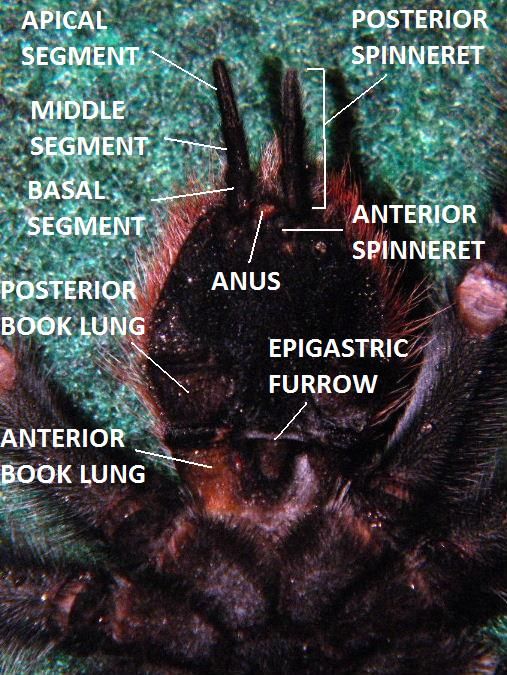
Fig. 3. Ventral view of the cephalothorax. Note it is quite common to see the maxilla referred to as palpal coxa in some papers.
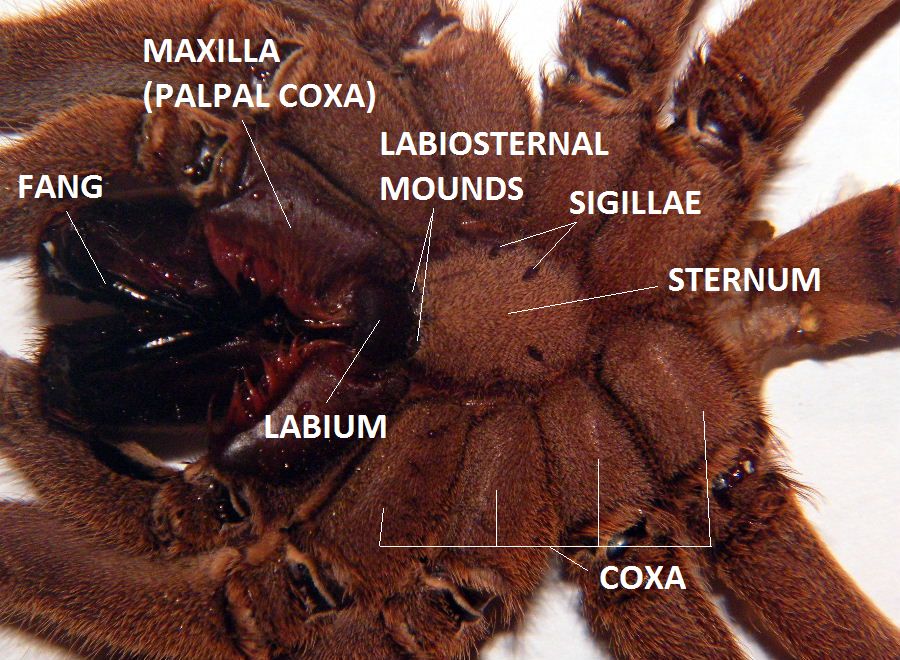
Fig. 4. Inside face (prolateral) of the chelicerae showing the fang and cheliceral teeth.
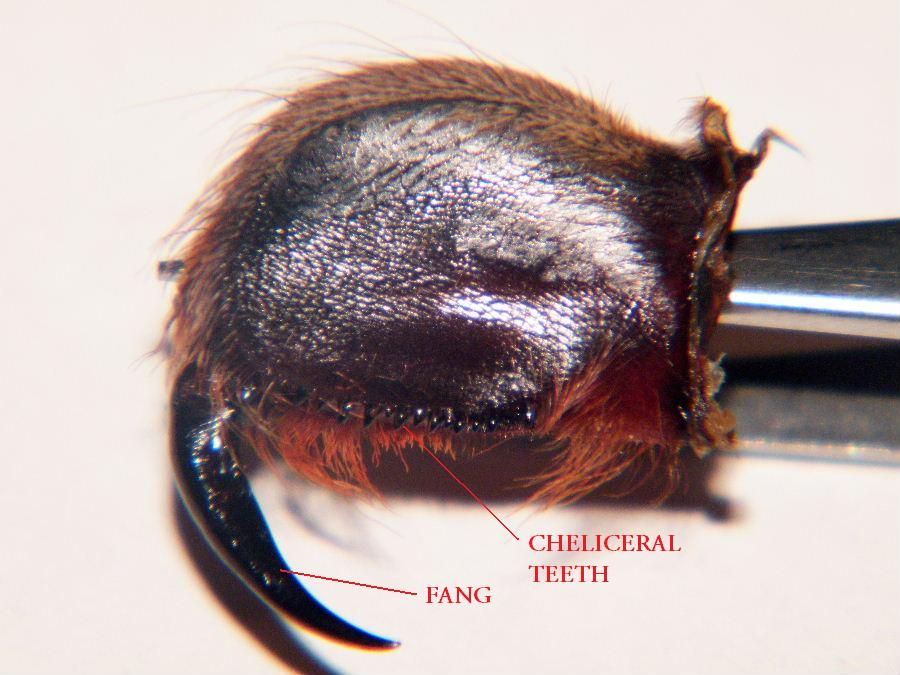
Fig. 5. Close up of cheliceral teeth. Sometimes the pattern of these are recorded using a V for large teeth and v for small teeth
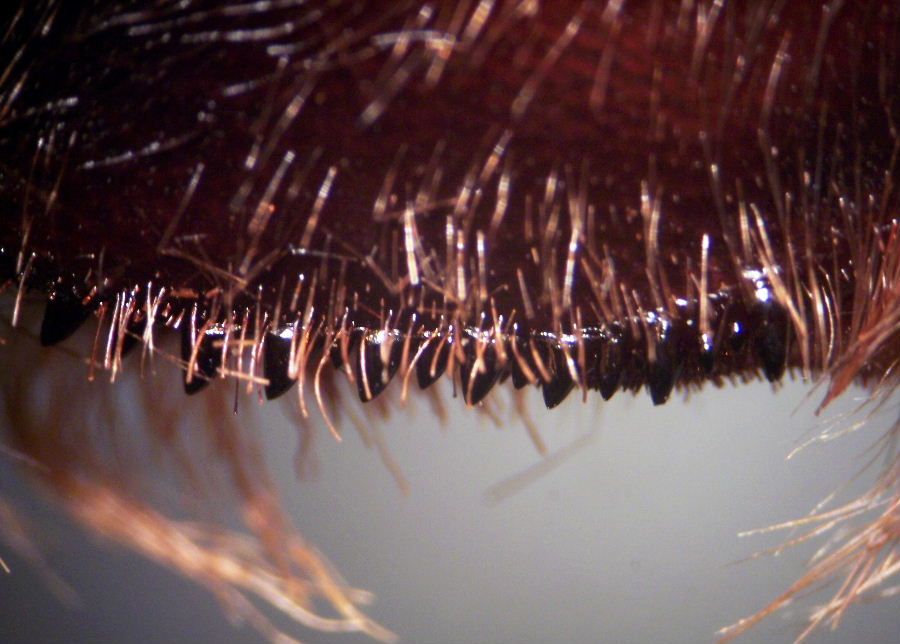
The leg, consisting of 7 segments. Usually each segment is measured dorsally with the total leg length being taken from the coxa to the end of the tarsus. In a lot of old descriptions the length of the patella + tibia compared to the length of the carapace was used as a taxonomic tool.
Fig. 6. Leg I of a Chilobrachys species.
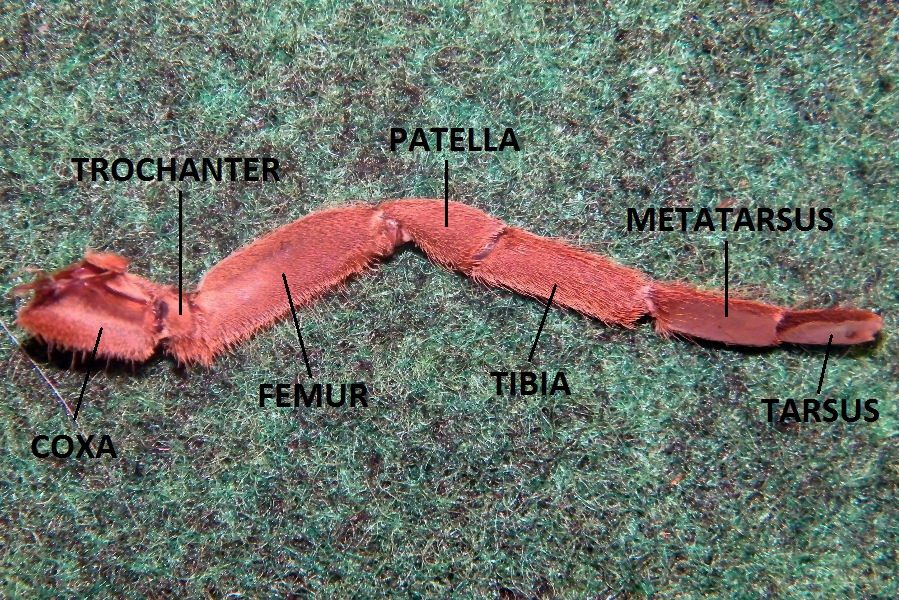
On the distal end of the tarsus there are usually 2 small black retractable tarsal claws. In some genera such as Phlogiellus there is a smaller 3rd claw present.
Fig. 7. Close up of the tarsus of a Chilobrachys species.
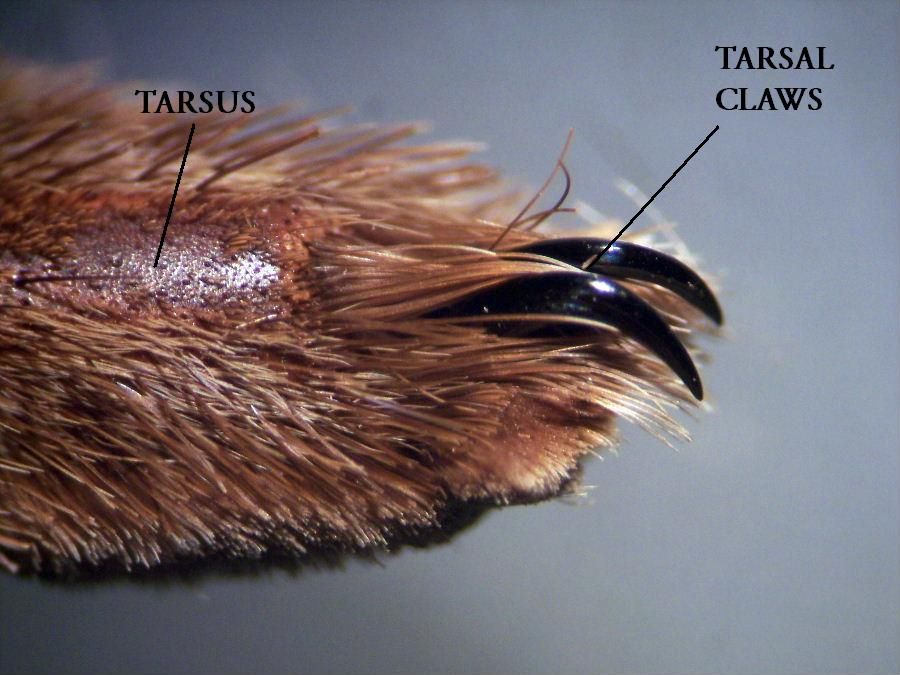
Fig. 8.Tarsal claws removed from leg of a Phlogeillus sp. Koh Samui.
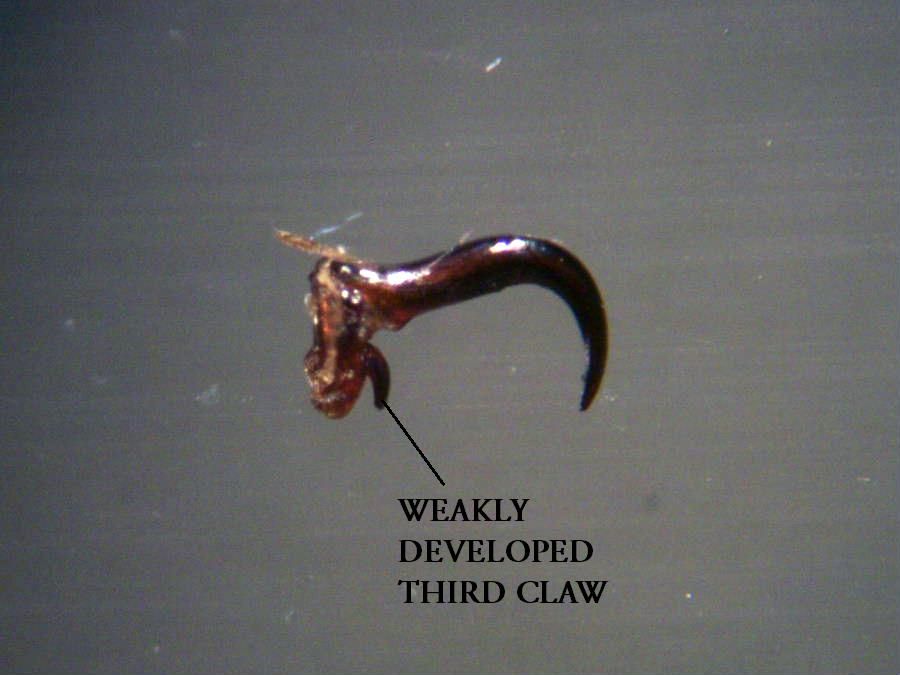
Fig. 9. The pedipalp. Looks very much like a small leg but as you can see it lacks a metatarsus.
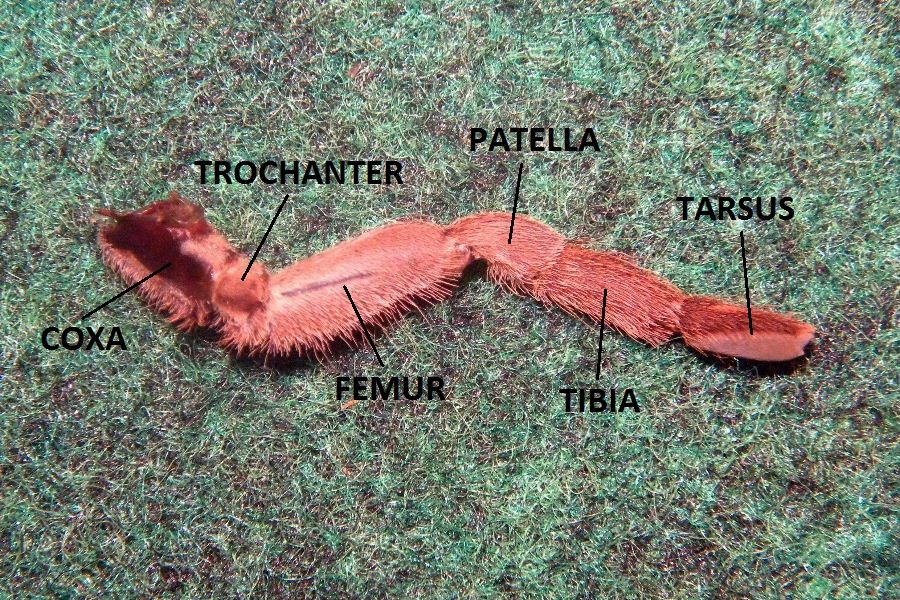
Anatomical directions and locations
Before looking into various body parts in more depth it is probably best to get to grips with some basic anatomical directions. The main ones being anterior, posterior, retrolateral, prolateral, medial, proximal and distal.
Anterior. Situated at, relatively near to, or concerning or facing the front. Usually the end directed forwards when the animal is moving normally. It is derived from the Latin word ante meaning "before" or "in front of". It is shown in Fig. 10 as a black arrow.
Posterior. Situated behind, at, or relatively near the rear end. It is derived from the Latin word post meaning "after" or "behind". It is shown in Fig. 10 as a white arrow.
Retrolateral. Projecting from, or on, the side facing backwards. It is derived from the Latin words retro meaning "backwards" and lateralis meaning "to the side". The retrolateral sides of the spider’s appendages are shown in blue.
Prolateral. Projecting from, or on, the side facing forwards. It is derived from the Latin words pro meaning "for" or "forward" and again lateralis meaning "to the side". The prolateral sides of the spider’s appendages are shown in red.
Medial. Situated in the middle (of an organism or limb). It is derived from the Latin word medius meaning "middle". The medial lines of the carapace, abdomen and leg are shown in pink.
Proximal. Nearest to the centre. Nearest to the body (as of a limb or appendage); nearest to a defined point on or within the body. It is derived from the Latin word proximus meaning "nearest". I have marked proximal points in orangey yellow on different segments of each limb in the photograph below. For example the palpal femur or the tibia on leg I.
Distal. Away from the centre. Away from the body (as of a limb or appendage); away from a defined point on or within the body. It is derived from the Latin word distare meaning "to stand away from". I have marked distal points in green on the same segments the proximal points were marked on (palpal femur, tibia leg I etc).
Fig. 10. Anatomical directions
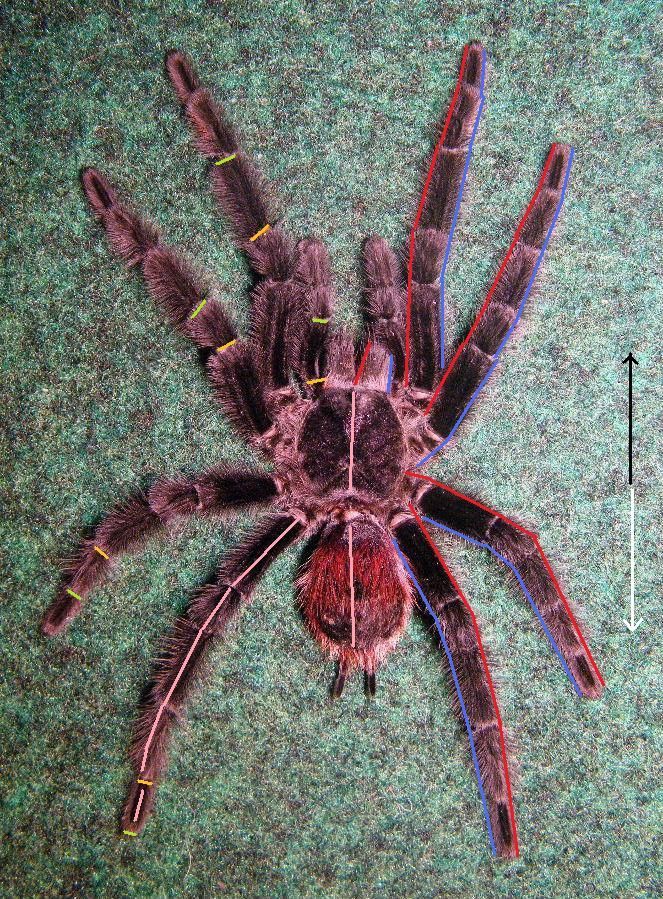
Another couple of terms not shown in the diagram are superior and inferior.
Superior. Higher, upper, anterior, of one structure above another. It is Latin for "above" or "over".
Inferior. Applied to any structure beneath or below another structure. It is Latin for "below".
We will see an example of these two later on when we look at the placement of keels on palpal bulbs.
These anatomical terms can be combined together to give an accurate description of the location of certain features such as spine placement on the legs, particularly on the tibia and metatarsus of legs III & IV, for example. In Fig. 11, using the tibia of a left leg I, I have numbered various points on the ventral and dorsal side and given the relevant anatomical term of location below.
Fig.11. Ventral and dorsal views of leg I showing spine locations.
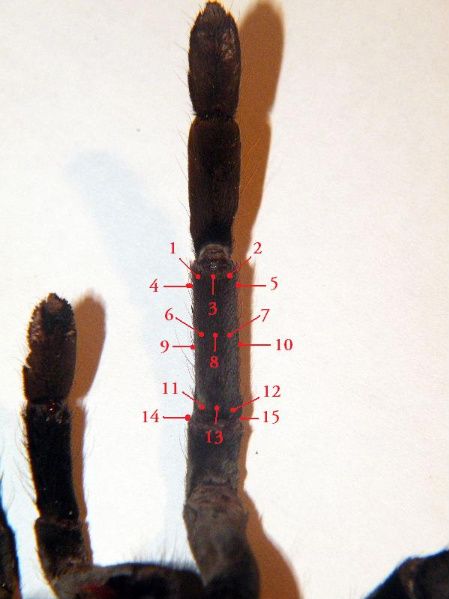
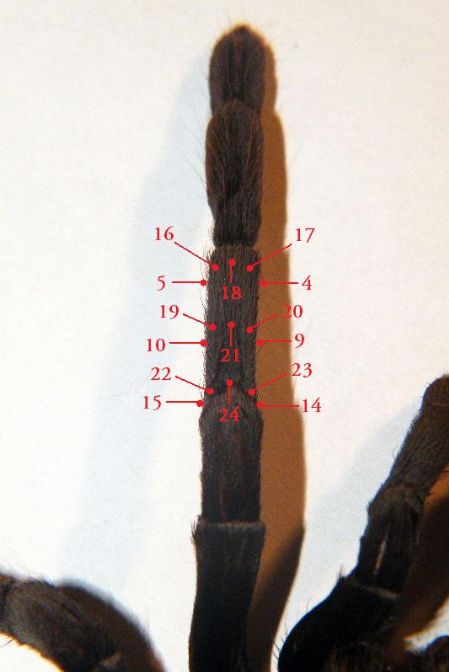
1. DPV - distal proventral ........................13. PMV - proximal midventral
2. DRV - distal retroventral ......................14. PPL - proximal prolateral
3. DMV - distal midventral .......................15. PRL - proximal retrolateral
4. DPL - distal prolateral ..........................16. DRD - distal retrodorsal
5. DRL - distal retrolateral .......................17. DPD - distal prodorsal
6. MPV - medial proventral .....................18. DMD - distal middorsal
7. MRV - medial retroventral ...................19. MRD - medial retrodorsal
8. MMV - medial midventral ....................20. MPD - medial prodorsal
9. MPL - medial prolateral .......................21. MMD - medial middorsal
10. MRL - medial retrolateral ..................22. PRD - proximal retrodorsal
11. PPV - proximal proventral .................23. PPD - proximal prodorsal
12. PRV - proximal retroventral ..............24. PMD - proximal middorsal
The Cephalathorax
With our new found knowledge of spider anatomy and anatomical directions we can begin to look at various parts of the spider in more detail starting with the carapace.
As mentioned earlier, many old descriptions relied on comparing the lengths of the patella + tibia of legs I-IV to the length of the carapace, but as theraphosid taxonomy progressed this was found to be a very limited tool. There are however, other features of the carapace that are of great use such as the foveal or thoracic groove, the ocular tubercle and the clypeus.
The foveal groove can vary greatly between species. It can be shallow or deep, transverse (straight), procurved (U-shaped), recurved (n-shaped) or in the case of, for example, some Ceratogyrus species such as C. marshalli or C. darlingi, have a horn or small mound rising above the carapace. In Fig. 13 you can see that the fovea is quite deep and very slightly procurved, almost transverse.
Fig. 13. Carapace of a Pamphobeteus antinous female.
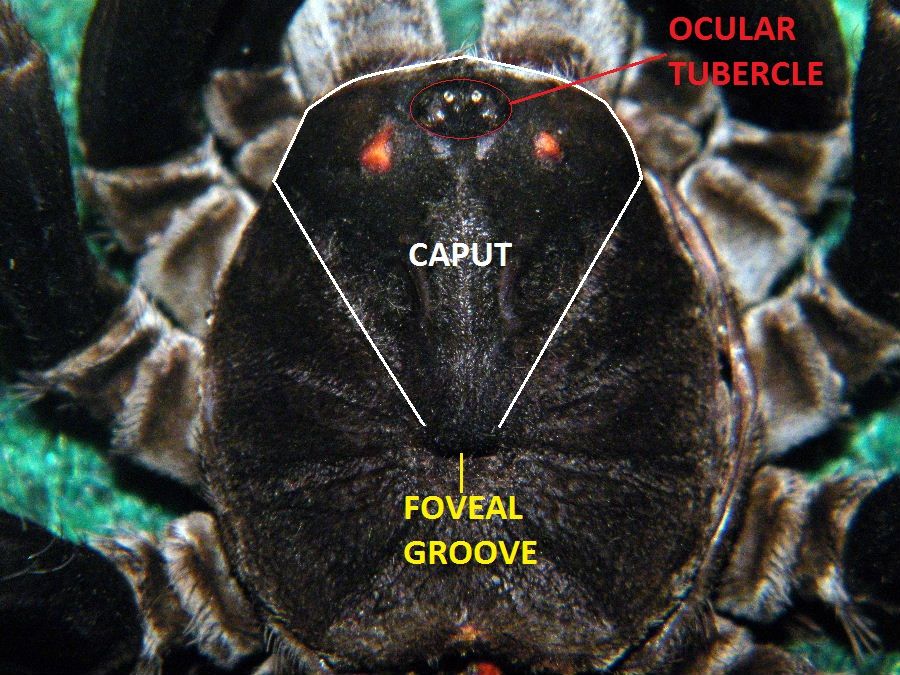
The ocular tubercle, also referred to as eye turret or eye hill houses the eyes of the tarantula, the layout of which used to be considered a primary taxonomic tool but has been found to be unstable in a lot of species. Tarantulas usually have 8 eyes which are separated into 2 rows, anterior row and posterior row. The eyes situated on the outside are known as lateral eyes and those on the inside are median eyes. So this gives us anterior lateral eyes (ALE), anterior median eyes (AME), posterior lateral eyes (PLE) and posterior median eyes (PME). Note that in a lot of descriptions they are referred to by their acronyms. Looking at the eyes on the photo below we can see that the anterior eye row is procurved and the posterior eye row is transverse.
A more reliable taxonomic tool is the clypeus. This is the area between the ocular tubercle and the anterior edge of the carapace. This can be wide, narrow or even absent in some genera such as Anoploscelus or Chaetopelma. In the example below the clypeus is narrow.
Fig. 14. Encyocratella olivacea ocular tubercle.
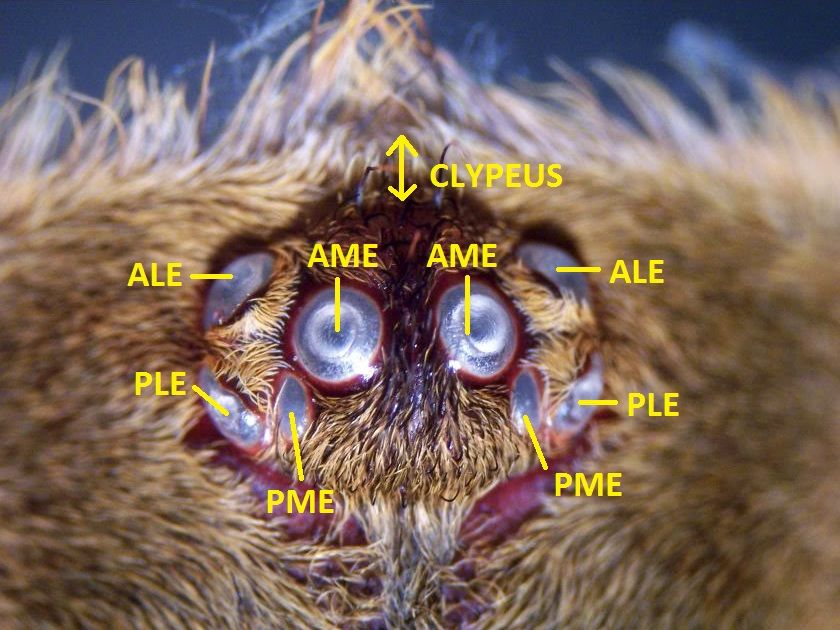
Next we will have a closer look at the labium. As you can see from Fig. 15 & Fig.16, there are little black bumps or granules on the labium and ventral maxillae. These are known as cuspules and the layout and number present a useful taxonomic tool. In the example in Fig. 15 you can see that there are not many cuspules on the labium and therefore can be easily counted. This is not always the case and so in the example shown in Fig 15 a rough estimate is taken by counting the number of cuspules in a horizontal row and multiplying it by the number of cuspules in a vertical row.
In the suture between the labium and the sternum you can see the labiosternal mounds. These were first noticed in theraphosids by the Australian taxonomist Robert Raven and described in his 1985 work The Spider Infra order as "a uniquely modified labiosternal junction: instead of being a shallow or hardly defined "groove," as in most mygalomorphs, the "groove" is inverted so that two distinct narrow mounds with several peaks or teeth are present. The mounds are best developed in Haploclastus, in which they are bicuspidate, but the mounds are not present in Phlogiellus, Haploclastus, Lyrognathus, or some Selenocosmia species." So the presence or absence of these mounds or, as in the case of the Heteroscodra genus, the distinct shape, means it can be a useful tool.
Fig. 15. Heteroscodra maculata.
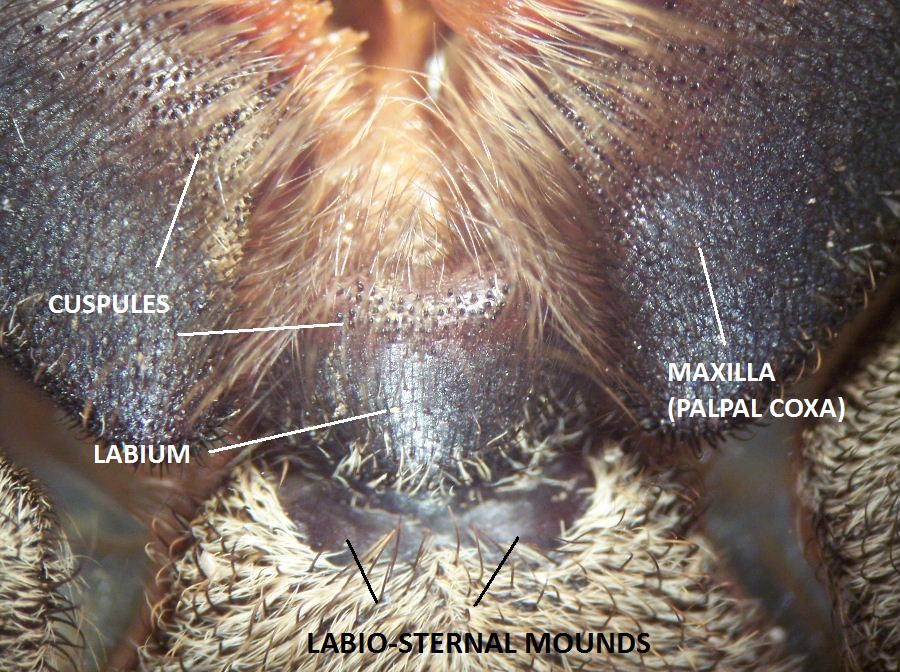
Fig. 16. Labium with cuspules.
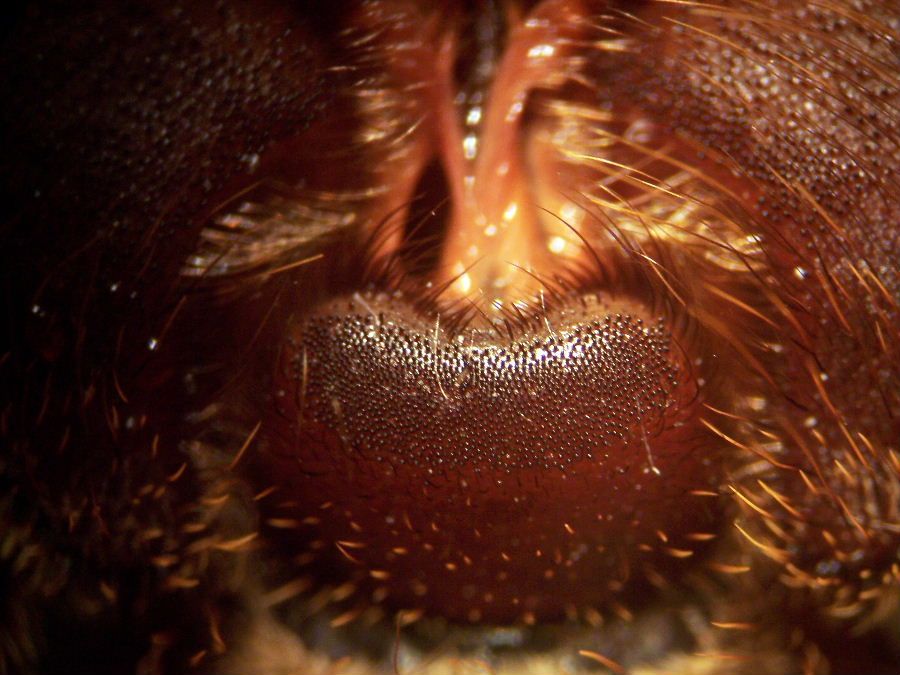
Sexual organs.
The morphology of the sexual organs have long been regarded a useful primary taxonomic tool usually more so the male palpal bulb probably due to its easy access compared to the female's spermathecae that has to be dissected out of the dead spider. That said we shall look at the female organs first.
Spermathecae can come in many different shapes and sizes but the three main types are fused, paired and partially fused (at the base) with twin receptacles. In description papers spermathecae are nearly always drawn or photographed from the dorsal side.
Fused spermathecae are a single structure. It is believed that they start off as two separate structures and then fuse together as the spider moults. If this is the case then it is done within the first few instars.
Fig. 17. Cyriopagopus minax fused spermathecae
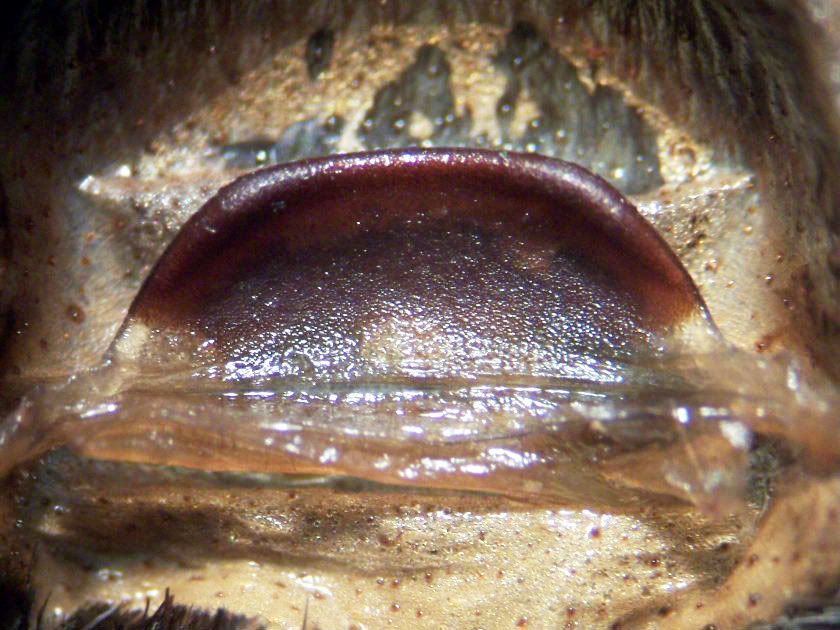
Fig. 18. Ornithoctoninae sp. Borneo paired spermathecae.
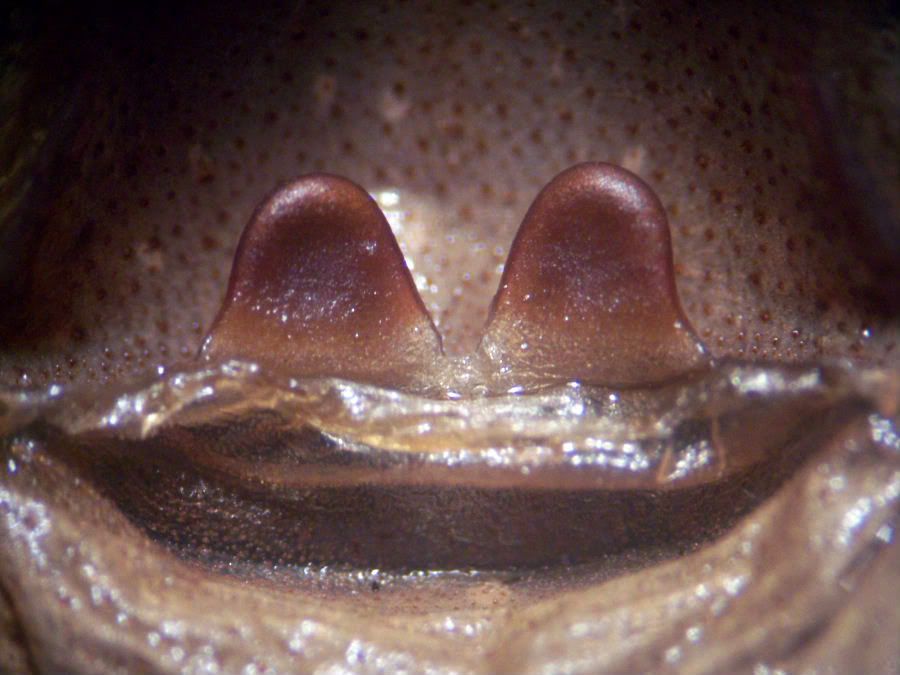
Fig. 19. Lasiodora parahybana spermathecae fused at the base with twin seminal receptacles
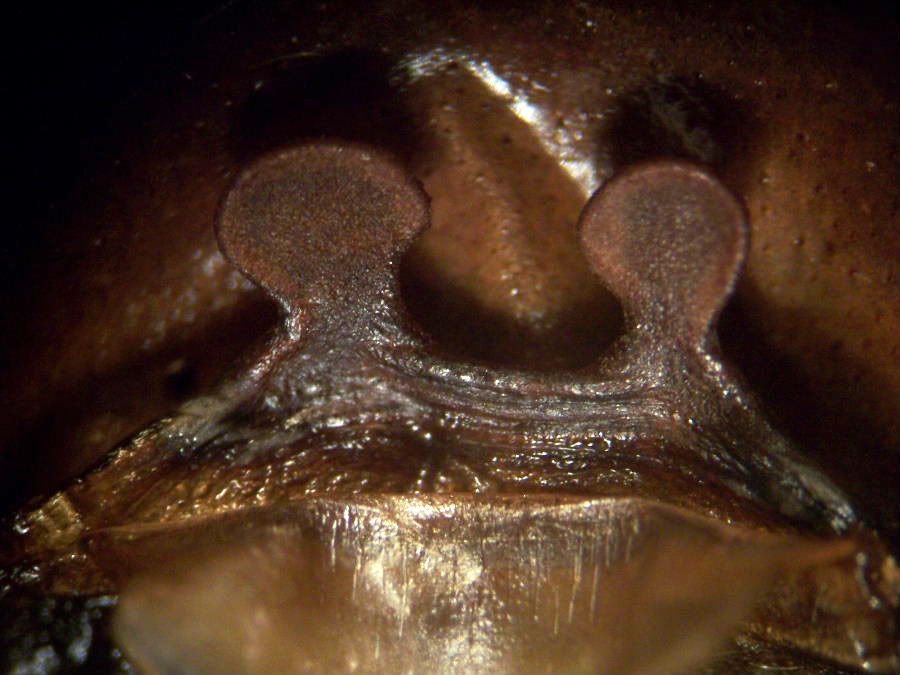
To see a whole range of weird and wonderful looking spermathecae have a look at the spermathecae gallery here or visit Mikhail's wonderful website here. Also for more information on various sexual organ related structures why not pay the sexing guide here a visit.
The palpal organ has been used as a taxonomic tool since as far back as the 1870's and since it acts as a key that can usually only fit the epigyne of that particular species, it makes for a very useful taxonomic feature. However, the downside to it is that it is only useful for helping identify the male of the species and only mature ones at that.
Fig. 20 shows the palp of a mature male. The palpal tarsus is referred to as the cymbium. Once the male has matured it changes from an elongated spade shape to a short rounded structure (often referred to as "boxing gloves" by many hobbyists).
Fig. 20. Male pedipalp.

The palpal bulb itself is usually pear shaped with a long fine embolus running off it. They are often adorned with ridges which are called keels. In Fig. 21 this particular bulb has 2 keels running along the prolateral side. They are the prolateral superior keel (PS) and the prolateral inferior keel (PI). There are other keels that can be found on palpal bulbs such as the apical (A), sub apical (SA) and retrolateral (R) keels but unfortunately I do not have the material to show all of these. For more examples I would suggest reading Bertani, R. 2000. Male palpal bulbs and homologous features in Theraphosinae (Araneae, Theraphosidae). Journal of Arachnology 28: 29-42.
Fig. 21. Grammostola actaeon bulb, retrolateral view.
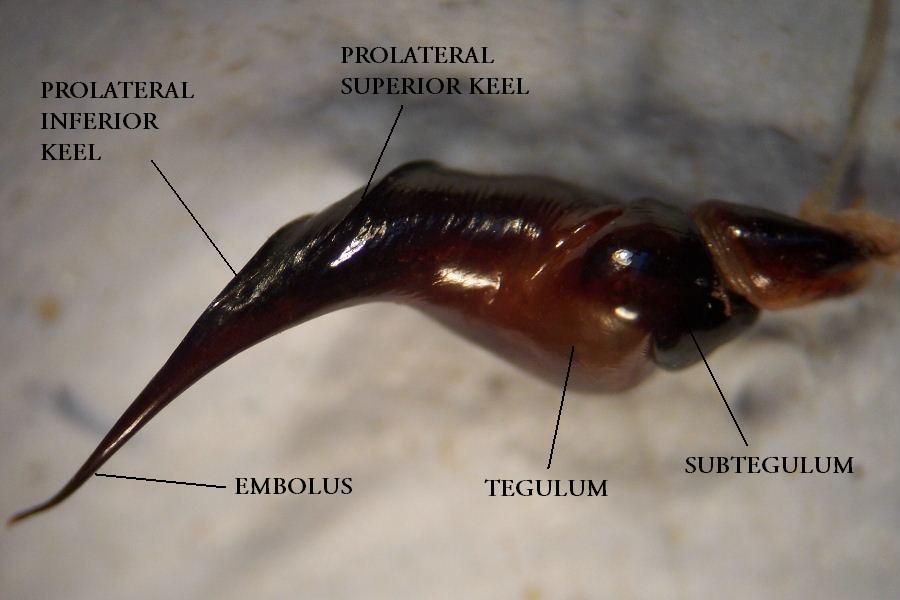
Fig. 22. Brachypelma boehmei bulb, retrolateral view.
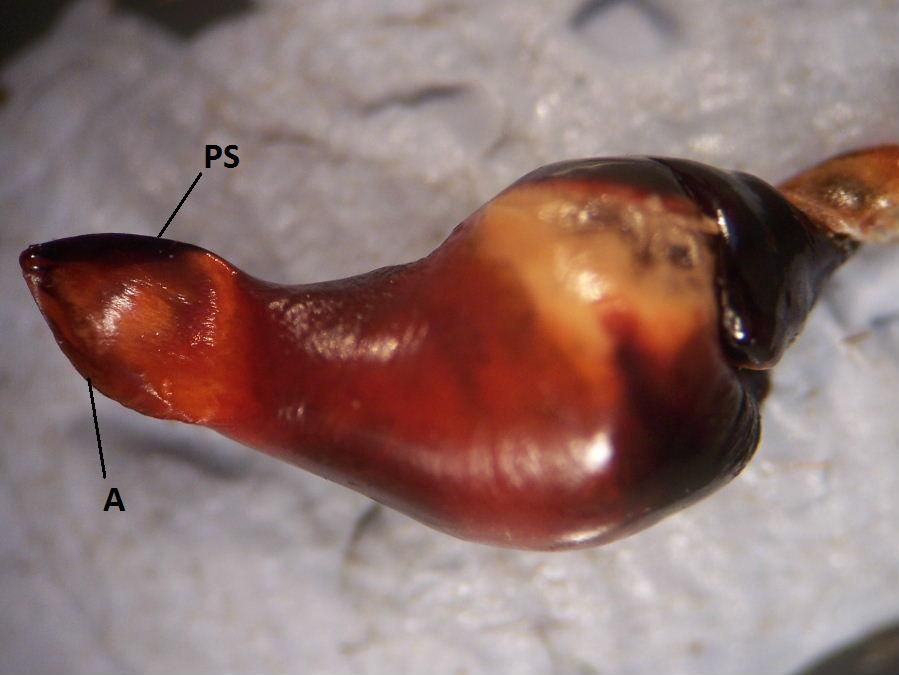
Fig. 23. Brachypelma boehmei bulb, prolateral view.
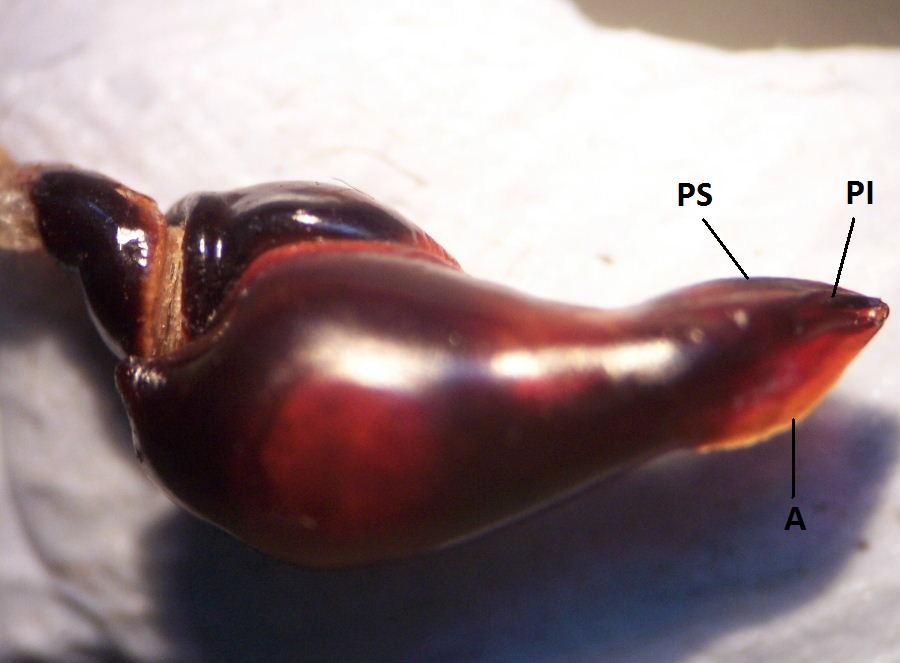
The tibial spurs or tibial apophysis, of the mature male are often a useful taxonomic tool on a generic level. The presence or absence of these spurs as well as the shape and spination of them are used for identification purposes. They are located on the distal end of the tibia and can range from one or two spurs to a cluster of spines or even a single spine (often referred to as a megaspine). In Fig. 25 the specimen has a primary segment or branch with a spine on the end and in Fig. 26 it has a primary and secondary segment.
Fig. 24. Male leg I. Notice the curved metatarsus. This is particularly prominent in species such as Hapalopus and Haplotremus.
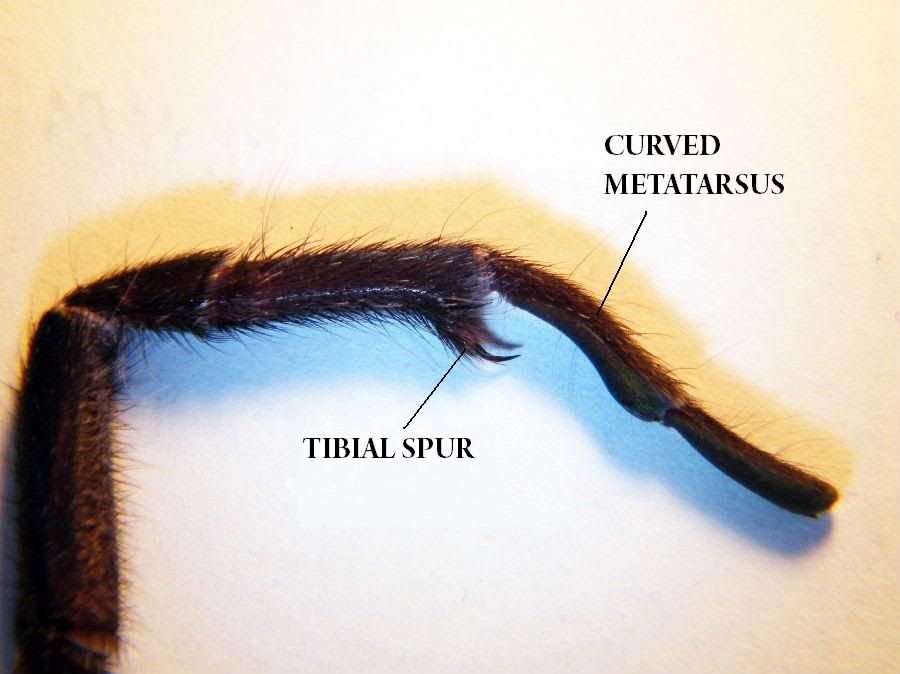
Fig. 25. Grammostola actaeon tibial spur.
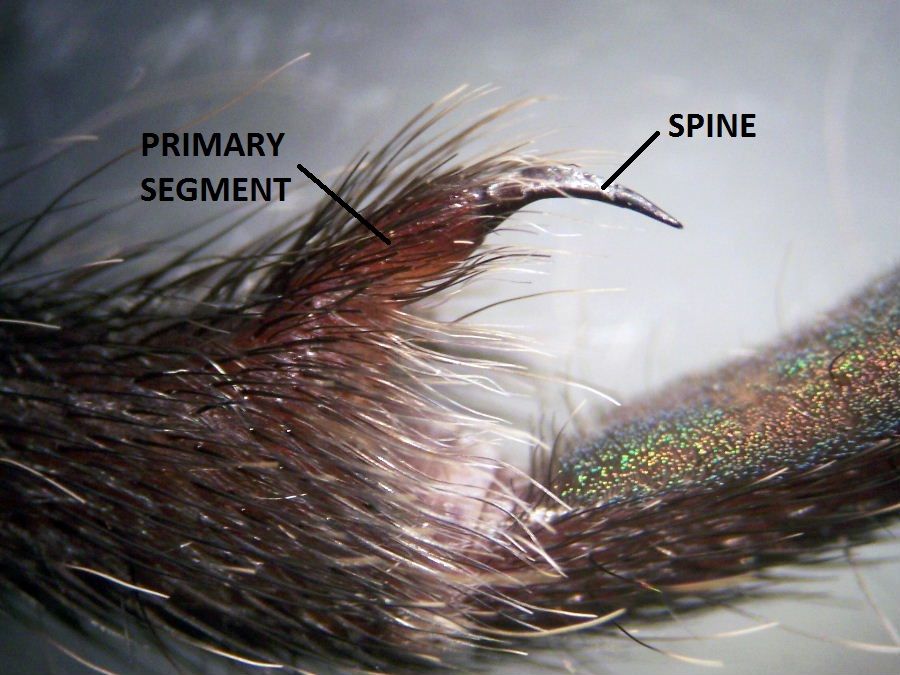
Fig. 26. Brachypelma boehmei tibial spurs.
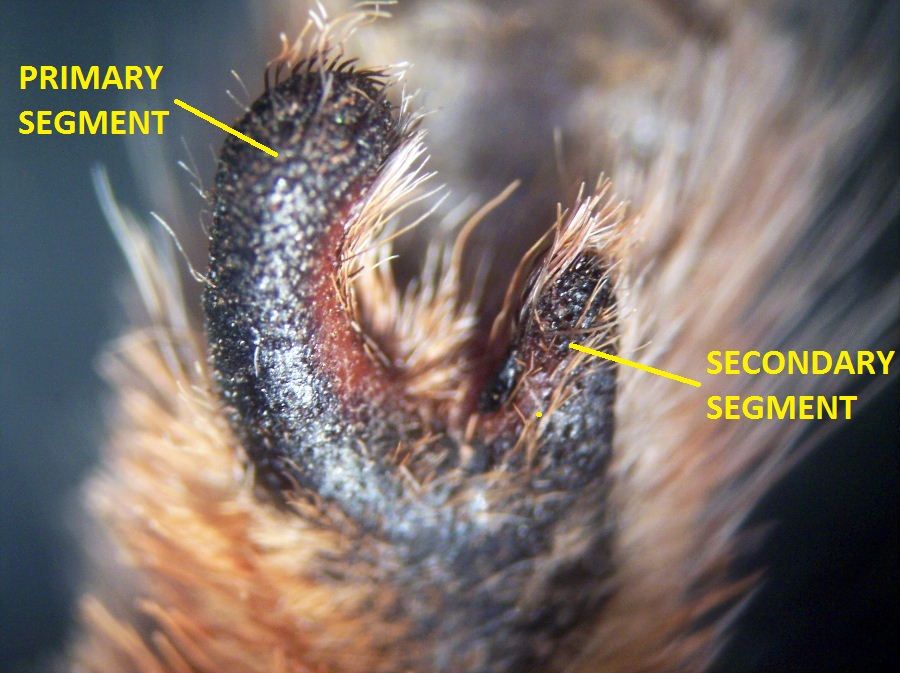
Tarsal and metatarsal scopula
The presence or absence of a dividing line in the metatarsal and tarsal scopula of leg III and IV is a taxonomic tool that has been used as far back as 1871 by Anton Ausserer and continued by Eugene Simon. However Reginald Po**** raised doubts about the validity of this tool when he pointed out that tarantulas do not have scopulae on the tarsus when very young. With each moult the scopula increases in number starting from the edge of the segments and working their way in. So this tool can really only be used when describing full adult specimens. However, Andrew Smith does state in his Baboon Spiders book that it is an important taxonomic character for Ischnocolinae and Eumenophorinae. The examples in Figs. 27-29 show the metatarsus and tarsus of leg IV belonging to 3 different species.
Fig. 27. A Chilobrachys species showing the metatarsus and tarsus divided by a line of setae.
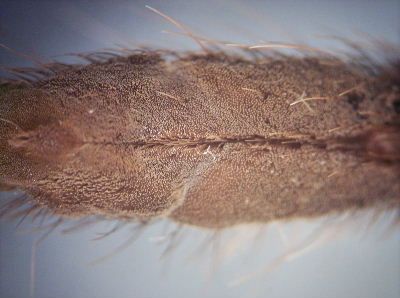
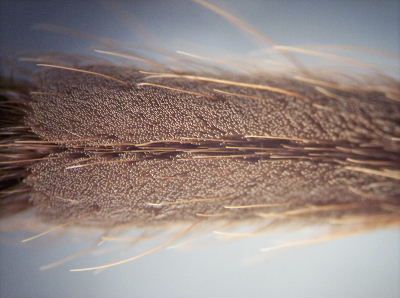
Fig. 28. An Avicularia species showing tarsal scopula undivided and metatarsal scopula divided by setae.
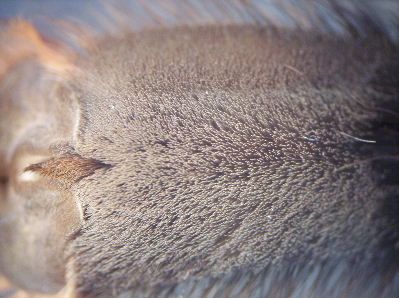
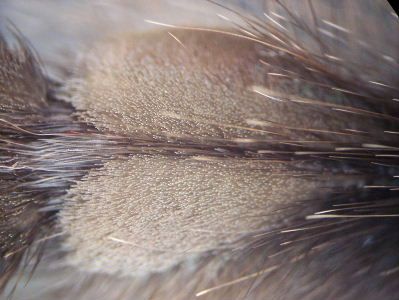
Fig. 29. An Omothymus species showing undivided tarsal and metatarsal scopula.
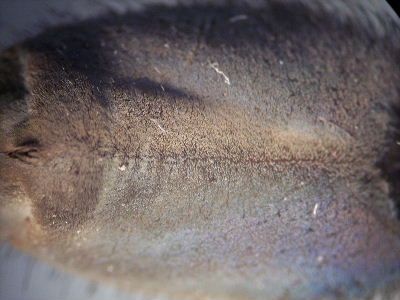

Another taxonomic use of the metatarsal scopula is the measurement of the amount of scopula found on the metatarsus. This is normally expressed either as a fraction e.g. a third scopulate, three quarters scopulate etc. or as a percentage. Usually legs I and II have complete coverage in most species so it is mainly used for the metatarsus of legs III and IV. In the example shown in Fig. 30 we can see that the metatarsus is roughly half scopulate.
Fig. 30. Leg IV of a Brachypelma species.
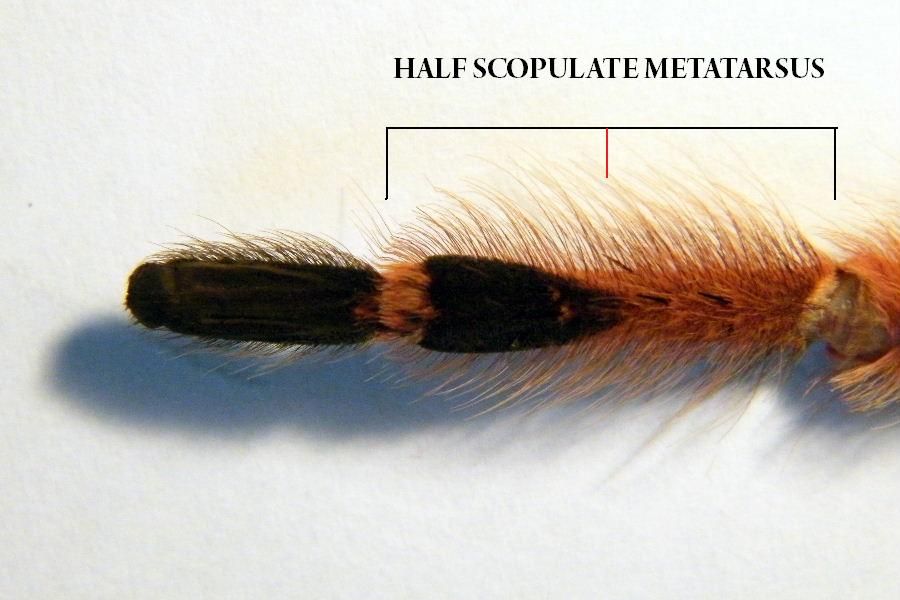
Stridulating organs
The primary stridulating organs are located on the retrolateral chelicerae and on the prolateral maxillae. They usually take the form of either small spikes on the chelicerae (known as strikers) with paddle and clavate setae on the maxillae or a patch of plumose setae (sometimes referred to as a scopulate pad) on the chelicerae with thorn like setae on the maxillae. The shape and pattern that these modified setae form are used as a taxonomic tool that is very useful in the identification of species. By rule they are usually only found on old world species but as usual there is always an exception to the rule and in this case it is the Psalmopoeus genus. Possessing lyra on the maxillae very similar to that found in genera belonging to the Selenocosmiinae subfamily, they however, do not possess strikers on the chelicerae although there are a few longer thicker set setae at the base.
Fig. 31. Strikers on the retrolateral chelicerae.
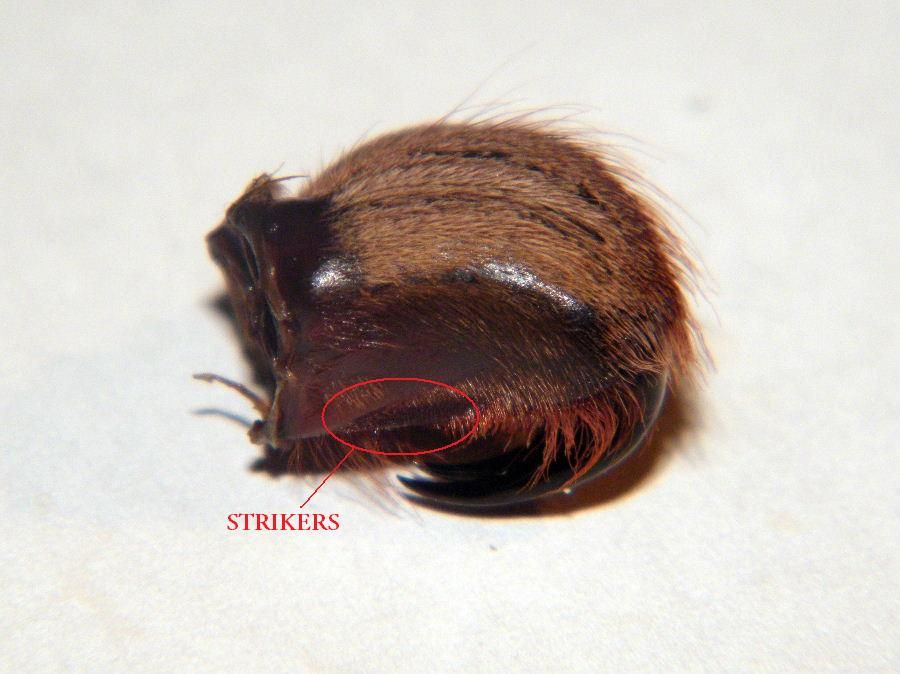
Fig. 32. Close up of strikers.

Fig. 33. Prolateral maxilla with paddle setae.
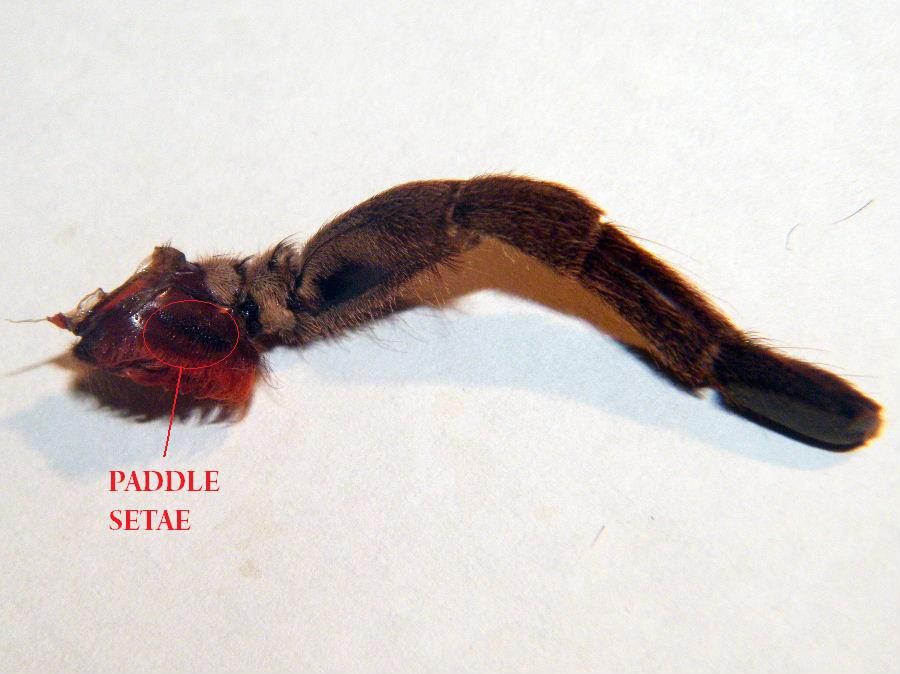
Fig. 34. Close up of the prolateral maxilla of Chilobrachys fimbriatus.
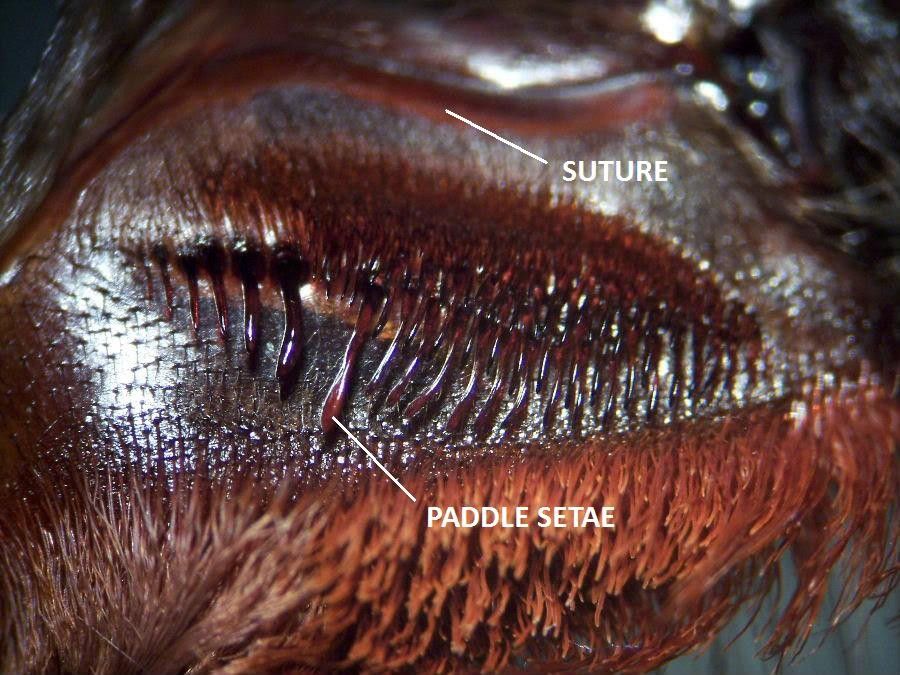
Fig. 35. Retrolateral chelicerae of Ornithoctoninae sp. Malaysia with plumose setae.
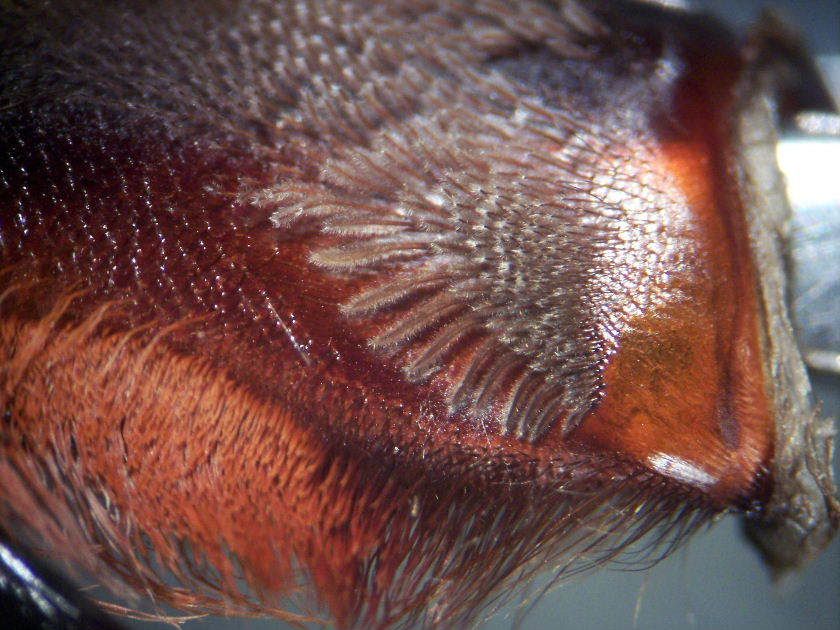
Fig. 36. Prolateral maxilla of Cyriopagopus longipes with thorn setae.
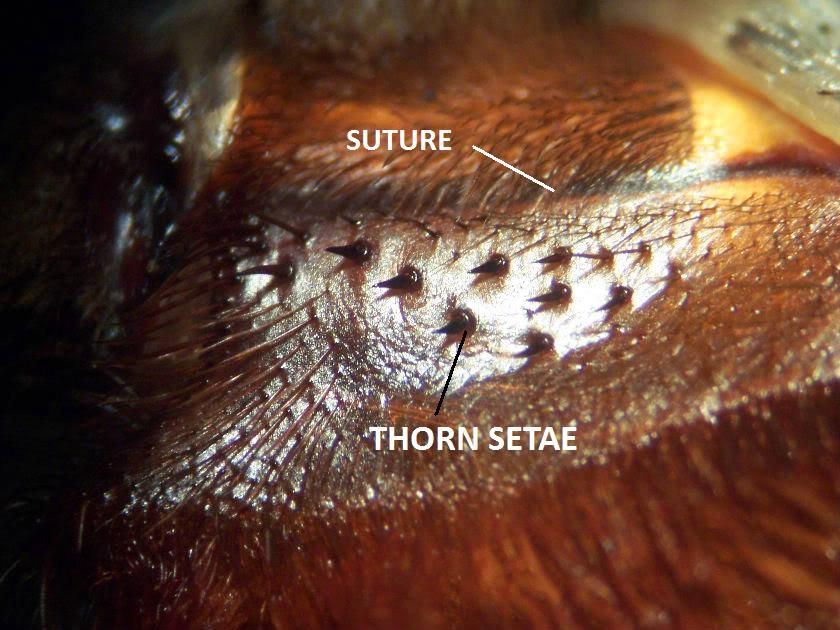
Secondary stridulating organs
In some genera, instead of having stridulating organs on the chelicerae and maxillae they have lyra on the retrolateral coxa and trochanter of the palp and the prolateral coxa and trochanter of leg I.
Fig. 37. Plumose setae on the retrolateral trochanter of a Theraphosa apophysis palp.
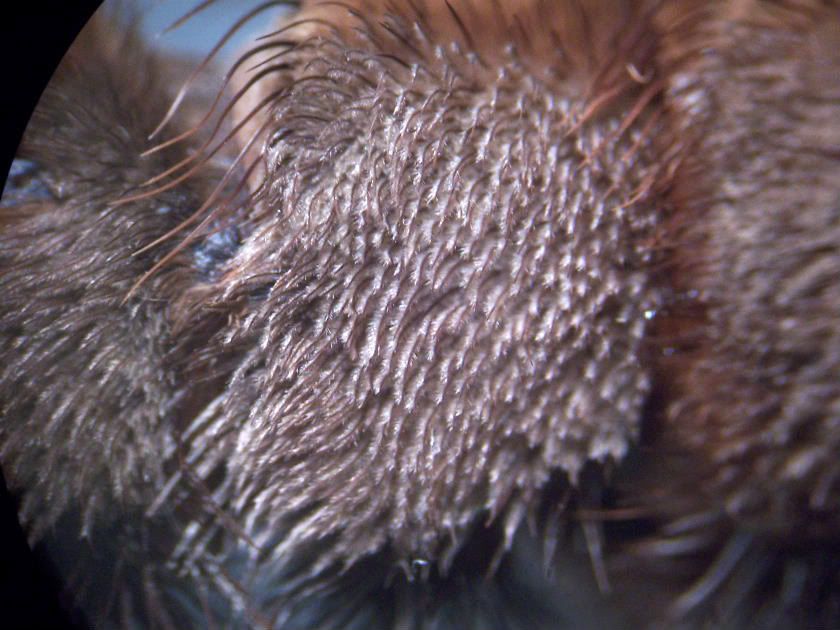
Fig. 38. Plumose setae on prolateral trochanter of leg I of a Theraphosa apophysis.
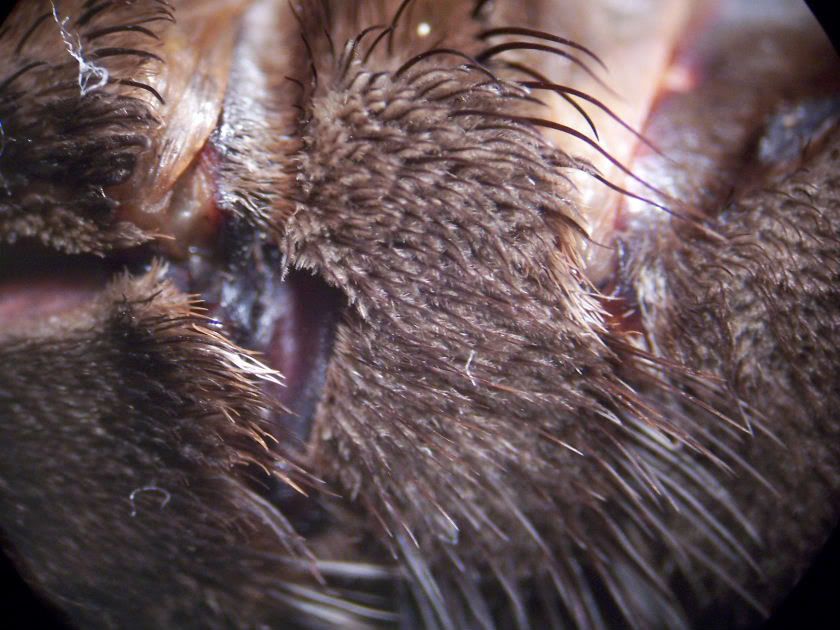
Fig. 39. Lyra on the retrolateral palpal coxa of Grammostola rosea.
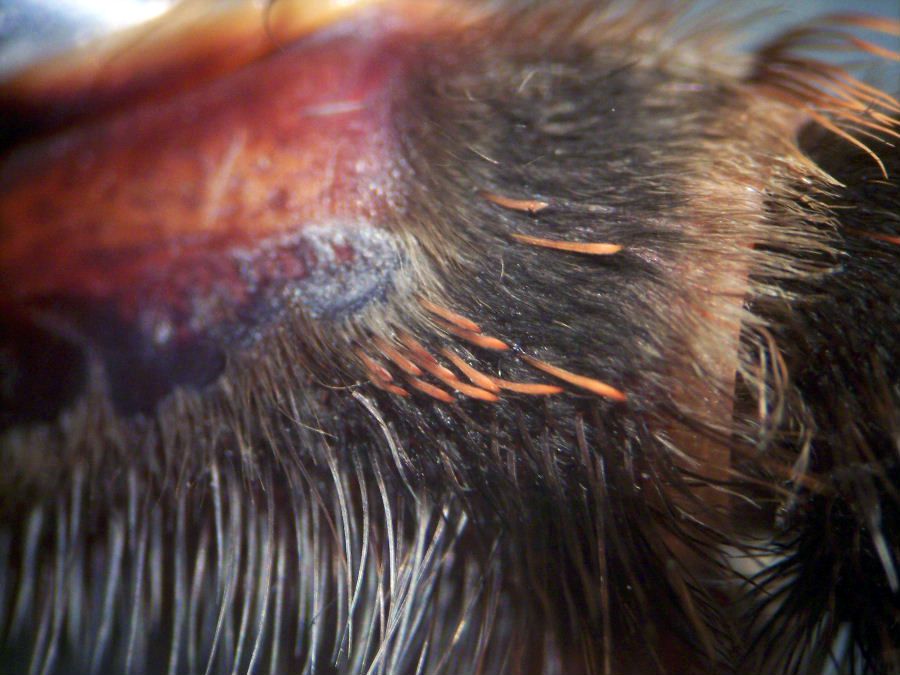
Fig. 40. Lyra on the prolateral coxa of leg I. Grammostola rosea.
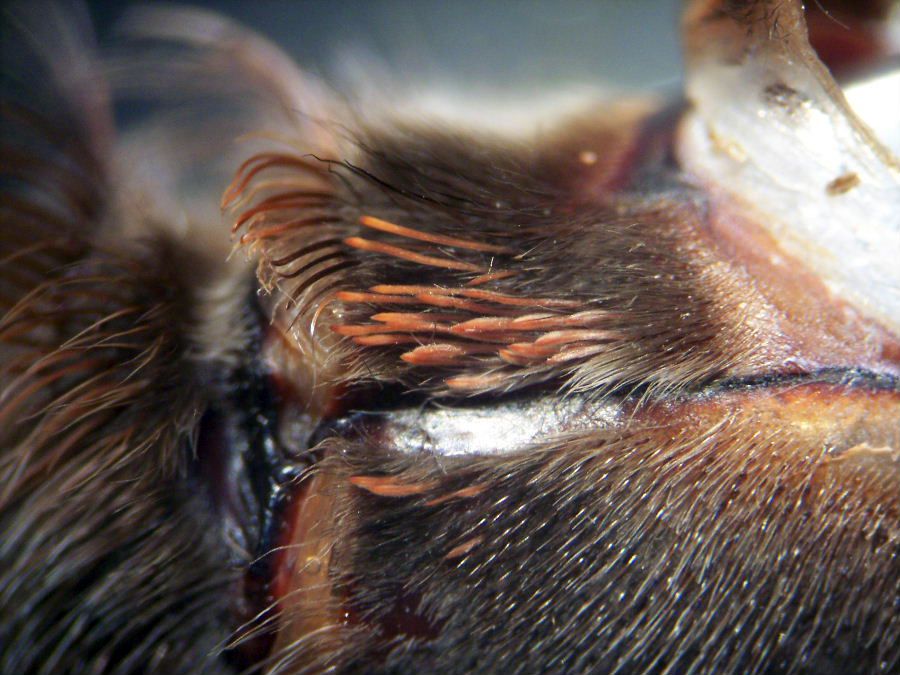
For more examples of stridulating organs check out the gallery here
Urticating hair
There are currently six known different types of urticating hair which are only found in the subfamilies Theraphosinae and Aviculariinae. The presence or absence of each of these types of hair can be a useful tool in identifying genera specific to these subfamilies. Types I, III & IV are found in genera belonging to Theraphosinae. Two different types of setae can be found in the same specimen, usually separated into different areas of the spider’s abdomen.
Type II urticating hair are only found on some species in the Aviculariinae subfamily.
Fig. 41. Urticating hair types I-VI.
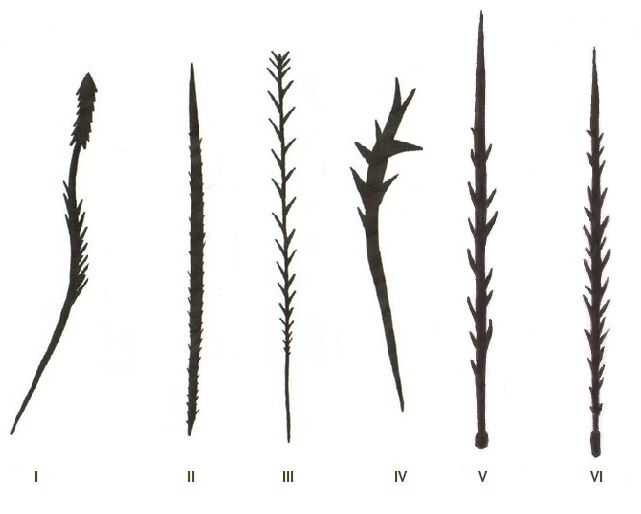
Type V have so far only been found on the prolateral femur of the pedipalp of Ephebopus species (as opposed to the abdomen where urticating hair is usually found).
Fig. 42. Type V urticating hair on the prolateral palpal femur of Ephebopus murinus.
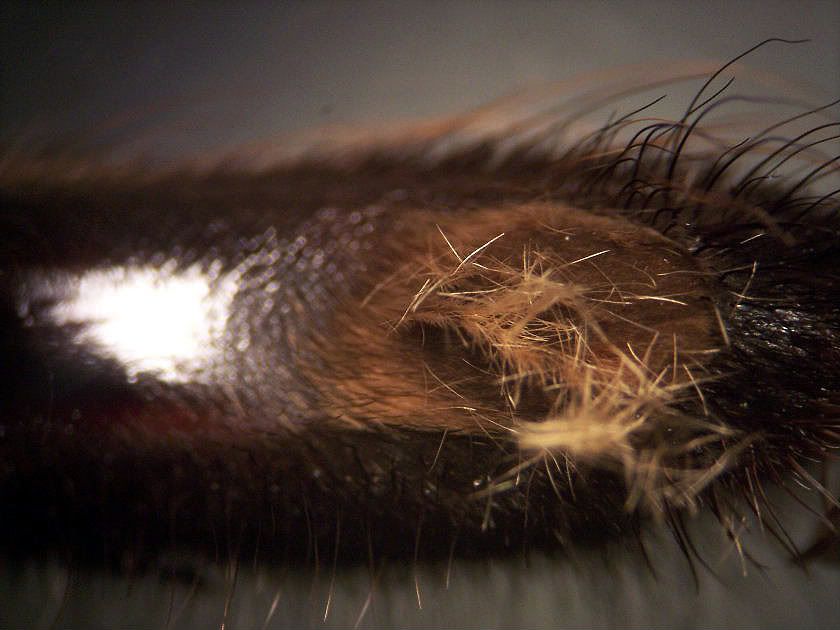
Type VI hairs were discovered on Hemirrhagus cervinus and describedby Fernando Perez Miles in 1998 and so far haven’t been found on any other genus. Like type V hairs, they are attached into a socket on the spider’s cuticle rather a stalk as with type I-IV.
Hopefully by now you will have a better understanding of the anatomy and terms used in theraphosid taxonomy and reading through description papers won't seem quite so daunting. I have compiled a glossary of terms used here and some others that are commonly used in various description papers.
Glossary of terms
Anterior - Situated at, relatively near to, or concerning or facing the front.
Apex - The tip or summit of a structure or organ.
Apophysis - An outgrowth or projection of an organ. The most common example being the tibial apophysis of a mature male.
Bacilliform - Rod shaped. Often used to describe certain stridulating setae.
Bicuspidate – Being double pointed; having two cusps or prominences.
Caput – A head-like protuberance of the anterior portion of the carapace.
Clavate - Club shaped. With the distal end swollen. This term is often applied to certain stridulating setae.
Clypeus - The area between the ocular tubercle and anterior edge of carapace.
Conical or sub conical - Cone shaped or almost cone shaped. Tends to crop up when describing the apical segments of Idiothele spinnerets.
Conical process – A cone-like projection such as the horn found on the carapace of some Ceratogyrus species and Sphaerobothria hoffmanni.
Cracked tarsus - A weakening of the exoskeleton of the tarsus that gives an effect that looks similar to a dried river bed.
Cuspules - Small granular bumps found on the labium and posterior ventral palpal coxa.
Cymbium - The palpal tarsus of a mature male.
Digitiform - Finger like in shape.
Distal - Situated away from the body.
Dorsal – On or in the region of the back of an animal. That part of the body normally directed upwards with reference to gravity.
Embolus - The tip of the palpal bulb that injects the sperm.
Filiform - Thread like in shape. Used to describe stridulating setae.
Fovea - A point of muscle attachment in the cephalothorax.
Foveal groove - Sometimes referred to as the thoracic groove. A straight or curved indentation on the carapace.
Habitus – The general appearance of an animal.
Holotype - The unique specimen designated to represent the concept for a named species. Also referred to as type specimen.
Homology - The recognition across taxa of identity among structures, behaviors, and other attributes, on the basis of similarity of form and position.
Incertae sedis - Of uncertain position. Applied to taxa, which for some reason, cannot be placed with certainty in a classification.
Incrassate - Thickened or swollen. Often used to describe leg segments.
Inferior - Applied to any structure beneath or below another structure. Often used to describe the placement of keels on palpal bulbs.
Keel - A ridge running along the palpal bulb or embolus.
Lancet/Lanceolate - Lance shaped. Tapering to a point like a surgical blade or a church window. Used to describe stridulating setae.
Labium - Plate on the ventral side of a spider that forms the back of its mouth.
Lectotype - A specimen, serving the function of a holotype, as designated from the members of a syntype series.
Lyra – A series of chitinous rods that form part of a stridulating organ.
Medial – Situated in the middle.
Median - Down the middle. Lying in the axial plane.
Neotype - A specimen selected to serve the function of the primary type, this being required because the holotype, lectotype or syntypes have been lost or destroyed.
Nomen dubium - Latin for doubtful name. A scientific name that is of unknown or doubtful application.
Nomen nudum - Latin for naked name. A name of a new taxon published without a description or diagnosis or reference to a description or diagnosis.
Ocular tubercle - Also known as the eye turret or eye hill. A small hump on the anterior carapace upon which the eyes are situated.
Opisthosoma - The posterior portion of the body. The abdomen.
Palpal bulb - Male sex organ used to store and transfer sperm.
Plesiomorphy - A primitive character, not group defining at the level at which it is being observed.
Plumose - Feather like in appearance. Used to describe stridulating setae.
Posterior - Situated behind, at, or relatively near the rear end.
Procurved - Curved forwards; in an arc with the ends foremost like a “U”. Most commonly used to describe the shape of the foveal groove or eye rows.
Prolateral - The forward facing side.
Prosoma - Anterior portion of the body. The cephalothorax.
Proximal - Situated near to the body.
Recurved – Curved backwards; in an arc with the ends rearmost like an “n”. Most commonly used to describe the shape of the foveal groove or eye rows.
Retrolateral - The rear facing side.
Sclerite - Seperate sclerotized structures connected to others by membranes.
Sclerotized - Hardened.
Scopula - A small tuft of dense hairs usually found on the legs and also chelicerae of some spiders.
Setae - A stiff hair or bristle.
Sigilla - Oval shaped points of muscle attachment on the sternum. Usually 3 pairs near the outside edge of the sternum.
Stridulating organs - Specialised setae found on the chelicerae and maxillae or on the coxa and trochanters which when rubbed together create a hissing sound.
Subtegulum - Sclerite located at the base of the palpal bulb.
Superior - Higher, upper, anterior, of one structure above another. Used to describe the placement of keels on palpal bulbs.
Suture - A line of junction. Usually refers to the line running through the prolateral maxilla.
Synapomorphy - Shared, derived, group defining trait.
Synonym - Two or more different names applied to the same taxon.
Syntype - Two or more specimens examined by the original author of a species, none of which was uniquely designated to serve as the name bearer for the taxon.
Taxon - A grouping of organisms at any level in the systematic hierarchy.
Tegulum - Sclerite forming the main lower portion of the bulb.
Transverse - Straight (-). Most commonly used to describe the shape of the foveal groove or eye rows.
Trichobothria - Specialised hairs on the legs of spiders that are used to detect air currents and vibrations.
Truncate - Square or broad at the apex almost as if it has been cut off.
Type species – The species used by the author of a genus to designate as the type of the genus.
Type specimen - See holotype.
Ventral - Underneath or lower surface.
This presentation was brought to you by the letters T,D,S and by the number 2.

Oh and these publications most of which can be found here
Bertani, R. 2000. Male palpal bulbs and homologous features in Theraphosinae (Araneae, Theraphosidae). Journal of Arachnology 28: 29-42.
Bertani, R. & J.P.L. Guadanucci. 2013. Morphology, evolution and usage of urticating setae by tarantulas (Araneae: Theraphosidae). Zoologia 30 (4): 403–418.
Cooke, J.A.L., V.D. Roth & F.M. Miller. 1972. The urticating hairs of Theraphosidae spiders. American Museum Novitates 2498: 1-43.
Foelix, R.F. 1996. Biology of Spiders. Oxford University Press.
Gallon, R.C. 2002. Revision of the African genera Pterinochilus and Eucratoscelus (Araneae, Theraphosidae, Harpactirinae) with description of two new genera. Bulletin of the British Arachnological Society 12: 201-232.
Han****, K. & Han****, J. 1989. Sex determination of immature theraphosid spiders from their cast skins.
Pérez-Miles, F., S.M.Lucas, P.I. da Silva Jr., & R. Bertani. 1996. Systematic revision and cladistic analysis of Theraphosinae. Mygalomorph 1: 33-68.
Pérez-Miles, F. 1998. Notes on the systematics of the little known theraphosid spider Hemirrhagus cervinus, with a description of a new type of urticating hair. Journal of Arachnology 26: 120-123.
Pérez-Miles, F. 1994. Tarsal scopula division in Theraphosidae (Araneae, Theraphosidae): Its systematic significance. Journal of Arachnology 22(1): 46-53.
Pérez-Miles, F. & L. Montes de Oca. 2005. Surface ultrastructure of labial and maxillary cuspules in eight species of Theraphosidae (Araneae). Journal of Arachnology 33(1): 43-49.
Petrunkevitch, A. 1925. Arachnida from Panama. Transactions of the Connecticut Academy of Arts and Sciences 27: 51-248.
Raven, R.J. 1985. The spider infra order Mygalomorphae (Araneae): cladistics and systematics. Bulletin of the American Museum of Natural History 182: 1-175.
Schuh, R.T. 2000. Biological Systematics. Principles and Applications. Cornell University Press.
Smith, A.M. 1988. The Tarantula. Classification and Identification Guide. Fitzgerald Publishing, London.
Smith, A.M. 1990. Baboon Spiders. Tarantulas of Africa and the Middle East. Fitzgerald Publishing, London.
Smith, A. M. 1995. Tarantula Spiders: Tarantulas of the U.S.A. and Mexico. Fitzgerald Publishing, London.
West, R.C., S.D. Marshall, C.S. Fukishima & R. Bertani (2008): Review and cladistic analysis of the Neotropical tarantula genus Ephebopus Simon 1892 (Araneae: Theraphosidae) with notes on the Aviculariinae. Zootaxa (1894): 35-58.
Williams, T. 2009. A Dictionary For Entomology. Lulu.com.
Online resources
Greek and Latin Roots in English - Oh no I've blown any credibility with the use of a dreaded wikipedia article.
Anatomical Directions - Bugger i did it again.
And a big thanks to Phil Rea for helping ensure this didn't become the ramblings of a total retard.
Mundo exotico
Well-Known Member
- Messages
- 231
- Location
- Lisbon
Thank you for this amazing info
Melissa Cat
New Member
- Messages
- 12
- Location
- St. Louis Missouri
TThiswas amazing
This was amazing. Do you have a scientific explanation of the molting process?The Beginners Guide to Understanding Theraphosid Taxonomy
by A.C. Himpanzee
The aim of this guide is to simply try and give you a better understanding of the various taxonomic terms and spider anatomy that are used in description papers and articles. Normally I would suggest to anyone interested in this sort of thing to seek out copies of Andrew Smith's excellent books, The Tarantula Classification and Identification Guide, Baboon Spiders Tarantulas of Africa and the Middle East or Tarantula Spiders Tarantulas of the USA and Mexico. Unfortunately, when I originally wrote this guide back in 2010 for a now defunct tarantula forum, all three books had been out of print for a number of years and on the odd occasion that they did crop up on sites such as ebay, they were usually going for a ridiculous sum of money like £250. So because there was no other books of their kind readily available at the time (in English anyway), I decided to knock up this guide.
Basic anatomy
To begin with we will start with the basic anatomy of a tarantula. You have probably seen loads of examples of these in books or online so you should already be familiar with most of the body parts labelled. Later on we will look at some of these parts in more detail.
Fig. 1. Dorsal view of the whole spider.

Fig. 2 Shows both pairs of book lungs, the epigastric furrow which is the opening to the gonopore (if male) or a gonoslit (if female), both anterior and posterior spinnerets labelling the 3 segments of the posterior pair and the anus.
Fig. 2. Ventral view of abdomen.

Fig. 3. Ventral view of the cephalothorax. Note it is quite common to see the maxilla referred to as palpal coxa in some papers.

Fig. 4. Inside face (prolateral) of the chelicerae showing the fang and cheliceral teeth.

Fig. 5. Close up of cheliceral teeth. Sometimes the pattern of these are recorded using a V for large teeth and v for small teeth

The leg, consisting of 7 segments. Usually each segment is measured dorsally with the total leg length being taken from the coxa to the end of the tarsus. In a lot of old descriptions the length of the patella + tibia compared to the length of the carapace was used as a taxonomic tool.
Fig. 6. Leg I of a Chilobrachys species.

On the distal end of the tarsus there are usually 2 small black retractable tarsal claws. In some genera such as Phlogiellus there is a smaller 3rd claw present.
Fig. 7. Close up of the tarsus of a Chilobrachys species.

Fig. 8.Tarsal claws removed from leg of a Phlogeillus sp. Koh Samui.

Fig. 9. The pedipalp. Looks very much like a small leg but as you can see it lacks a metatarsus.

Anatomical directions and locations
Before looking into various body parts in more depth it is probably best to get to grips with some basic anatomical directions. The main ones being anterior, posterior, retrolateral, prolateral, medial, proximal and distal.
Anterior. Situated at, relatively near to, or concerning or facing the front. Usually the end directed forwards when the animal is moving normally. It is derived from the Latin word ante meaning "before" or "in front of". It is shown in Fig. 10 as a black arrow.
Posterior. Situated behind, at, or relatively near the rear end. It is derived from the Latin word post meaning "after" or "behind". It is shown in Fig. 10 as a white arrow.
Retrolateral. Projecting from, or on, the side facing backwards. It is derived from the Latin words retro meaning "backwards" and lateralis meaning "to the side". The retrolateral sides of the spider’s appendages are shown in blue.
Prolateral. Projecting from, or on, the side facing forwards. It is derived from the Latin words pro meaning "for" or "forward" and again lateralis meaning "to the side". The prolateral sides of the spider’s appendages are shown in red.
Medial. Situated in the middle (of an organism or limb). It is derived from the Latin word medius meaning "middle". The medial lines of the carapace, abdomen and leg are shown in pink.
Proximal. Nearest to the centre. Nearest to the body (as of a limb or appendage); nearest to a defined point on or within the body. It is derived from the Latin word proximus meaning "nearest". I have marked proximal points in orangey yellow on different segments of each limb in the photograph below. For example the palpal femur or the tibia on leg I.
Distal. Away from the centre. Away from the body (as of a limb or appendage); away from a defined point on or within the body. It is derived from the Latin word distare meaning "to stand away from". I have marked distal points in green on the same segments the proximal points were marked on (palpal femur, tibia leg I etc).
Fig. 10. Anatomical directions

Another couple of terms not shown in the diagram are superior and inferior.
Superior. Higher, upper, anterior, of one structure above another. It is Latin for "above" or "over".
Inferior. Applied to any structure beneath or below another structure. It is Latin for "below".
We will see an example of these two later on when we look at the placement of keels on palpal bulbs.
These anatomical terms can be combined together to give an accurate description of the location of certain features such as spine placement on the legs, particularly on the tibia and metatarsus of legs III & IV, for example. In Fig. 11, using the tibia of a left leg I, I have numbered various points on the ventral and dorsal side and given the relevant anatomical term of location below.
Fig.11. Ventral and dorsal views of leg I showing spine locations.


1. DPV - distal proventral ........................13. PMV - proximal midventral
2. DRV - distal retroventral ......................14. PPL - proximal prolateral
3. DMV - distal midventral .......................15. PRL - proximal retrolateral
4. DPL - distal prolateral ..........................16. DRD - distal retrodorsal
5. DRL - distal retrolateral .......................17. DPD - distal prodorsal
6. MPV - medial proventral .....................18. DMD - distal middorsal
7. MRV - medial retroventral ...................19. MRD - medial retrodorsal
8. MMV - medial midventral ....................20. MPD - medial prodorsal
9. MPL - medial prolateral .......................21. MMD - medial middorsal
10. MRL - medial retrolateral ..................22. PRD - proximal retrodorsal
11. PPV - proximal proventral .................23. PPD - proximal prodorsal
12. PRV - proximal retroventral ..............24. PMD - proximal middorsal
The Cephalathorax
With our new found knowledge of spider anatomy and anatomical directions we can begin to look at various parts of the spider in more detail starting with the carapace.
As mentioned earlier, many old descriptions relied on comparing the lengths of the patella + tibia of legs I-IV to the length of the carapace, but as theraphosid taxonomy progressed this was found to be a very limited tool. There are however, other features of the carapace that are of great use such as the foveal or thoracic groove, the ocular tubercle and the clypeus.
The foveal groove can vary greatly between species. It can be shallow or deep, transverse (straight), procurved (U-shaped), recurved (n-shaped) or in the case of, for example, some Ceratogyrus species such as C. marshalli or C. darlingi, have a horn or small mound rising above the carapace. In Fig. 13 you can see that the fovea is quite deep and very slightly procurved, almost transverse.
Fig. 13. Carapace of a Pamphobeteus antinous female.

The ocular tubercle, also referred to as eye turret or eye hill houses the eyes of the tarantula, the layout of which used to be considered a primary taxonomic tool but has been found to be unstable in a lot of species. Tarantulas usually have 8 eyes which are separated into 2 rows, anterior row and posterior row. The eyes situated on the outside are known as lateral eyes and those on the inside are median eyes. So this gives us anterior lateral eyes (ALE), anterior median eyes (AME), posterior lateral eyes (PLE) and posterior median eyes (PME). Note that in a lot of descriptions they are referred to by their acronyms. Looking at the eyes on the photo below we can see that the anterior eye row is procurved and the posterior eye row is transverse.
A more reliable taxonomic tool is the clypeus. This is the area between the ocular tubercle and the anterior edge of the carapace. This can be wide, narrow or even absent in some genera such as Anoploscelus or Chaetopelma. In the example below the clypeus is narrow.
Fig. 14. Encyocratella olivacea ocular tubercle.

Next we will have a closer look at the labium. As you can see from Fig. 15 & Fig.16, there are little black bumps or granules on the labium and ventral maxillae. These are known as cuspules and the layout and number present a useful taxonomic tool. In the example in Fig. 15 you can see that there are not many cuspules on the labium and therefore can be easily counted. This is not always the case and so in the example shown in Fig 15 a rough estimate is taken by counting the number of cuspules in a horizontal row and multiplying it by the number of cuspules in a vertical row.
In the suture between the labium and the sternum you can see the labiosternal mounds. These were first noticed in theraphosids by the Australian taxonomist Robert Raven and described in his 1985 work The Spider Infra order as "a uniquely modified labiosternal junction: instead of being a shallow or hardly defined "groove," as in most mygalomorphs, the "groove" is inverted so that two distinct narrow mounds with several peaks or teeth are present. The mounds are best developed in Haploclastus, in which they are bicuspidate, but the mounds are not present in Phlogiellus, Haploclastus, Lyrognathus, or some Selenocosmia species." So the presence or absence of these mounds or, as in the case of the Heteroscodra genus, the distinct shape, means it can be a useful tool.
Fig. 15. Heteroscodra maculata.

Fig. 16. Labium with cuspules.

Sexual organs.
The morphology of the sexual organs have long been regarded a useful primary taxonomic tool usually more so the male palpal bulb probably due to its easy access compared to the female's spermathecae that has to be dissected out of the dead spider. That said we shall look at the female organs first.
Spermathecae can come in many different shapes and sizes but the three main types are fused, paired and partially fused (at the base) with twin receptacles. In description papers spermathecae are nearly always drawn or photographed from the dorsal side.
Fused spermathecae are a single structure. It is believed that they start off as two separate structures and then fuse together as the spider moults. If this is the case then it is done within the first few instars.
Fig. 17. Cyriopagopus minax fused spermathecae

Fig. 18. Ornithoctoninae sp. Borneo paired spermathecae.

Fig. 19. Lasiodora parahybana spermathecae fused at the base with twin seminal receptacles

To see a whole range of weird and wonderful looking spermathecae have a look at the spermathecae gallery here or visit Mikhail's wonderful website here. Also for more information on various sexual organ related structures why not pay the sexing guide here a visit.
The palpal organ has been used as a taxonomic tool since as far back as the 1870's and since it acts as a key that can usually only fit the epigyne of that particular species, it makes for a very useful taxonomic feature. However, the downside to it is that it is only useful for helping identify the male of the species and only mature ones at that.
Fig. 20 shows the palp of a mature male. The palpal tarsus is referred to as the cymbium. Once the male has matured it changes from an elongated spade shape to a short rounded structure (often referred to as "boxing gloves" by many hobbyists).
Fig. 20. Male pedipalp.

The palpal bulb itself is usually pear shaped with a long fine embolus running off it. They are often adorned with ridges which are called keels. In Fig. 21 this particular bulb has 2 keels running along the prolateral side. They are the prolateral superior keel (PS) and the prolateral inferior keel (PI). There are other keels that can be found on palpal bulbs such as the apical (A), sub apical (SA) and retrolateral (R) keels but unfortunately I do not have the material to show all of these. For more examples I would suggest reading Bertani, R. 2000. Male palpal bulbs and homologous features in Theraphosinae (Araneae, Theraphosidae). Journal of Arachnology 28: 29-42.
Fig. 21. Grammostola actaeon bulb, retrolateral view.

Fig. 22. Brachypelma boehmei bulb, retrolateral view.

Fig. 23. Brachypelma boehmei bulb, prolateral view.

The tibial spurs or tibial apophysis, of the mature male are often a useful taxonomic tool on a generic level. The presence or absence of these spurs as well as the shape and spination of them are used for identification purposes. They are located on the distal end of the tibia and can range from one or two spurs to a cluster of spines or even a single spine (often referred to as a megaspine). In Fig. 25 the specimen has a primary segment or branch with a spine on the end and in Fig. 26 it has a primary and secondary segment.
Fig. 24. Male leg I. Notice the curved metatarsus. This is particularly prominent in species such as Hapalopus and Haplotremus.

Fig. 25. Grammostola actaeon tibial spur.

Fig. 26. Brachypelma boehmei tibial spurs.

Tarsal and metatarsal scopula
The presence or absence of a dividing line in the metatarsal and tarsal scopula of leg III and IV is a taxonomic tool that has been used as far back as 1871 by Anton Ausserer and continued by Eugene Simon. However Reginald Po**** raised doubts about the validity of this tool when he pointed out that tarantulas do not have scopulae on the tarsus when very young. With each moult the scopula increases in number starting from the edge of the segments and working their way in. So this tool can really only be used when describing full adult specimens. However, Andrew Smith does state in his Baboon Spiders book that it is an important taxonomic character for Ischnocolinae and Eumenophorinae. The examples in Figs. 27-29 show the metatarsus and tarsus of leg IV belonging to 3 different species.
Fig. 27. A Chilobrachys species showing the metatarsus and tarsus divided by a line of setae.


Fig. 28. An Avicularia species showing tarsal scopula undivided and metatarsal scopula divided by setae.


Fig. 29. An Omothymus species showing undivided tarsal and metatarsal scopula.


Another taxonomic use of the metatarsal scopula is the measurement of the amount of scopula found on the metatarsus. This is normally expressed either as a fraction e.g. a third scopulate, three quarters scopulate etc. or as a percentage. Usually legs I and II have complete coverage in most species so it is mainly used for the metatarsus of legs III and IV. In the example shown in Fig. 30 we can see that the metatarsus is roughly half scopulate.
Fig. 30. Leg IV of a Brachypelma species.

Stridulating organs
The primary stridulating organs are located on the retrolateral chelicerae and on the prolateral maxillae. They usually take the form of either small spikes on the chelicerae (known as strikers) with paddle and clavate setae on the maxillae or a patch of plumose setae (sometimes referred to as a scopulate pad) on the chelicerae with thorn like setae on the maxillae. The shape and pattern that these modified setae form are used as a taxonomic tool that is very useful in the identification of species. By rule they are usually only found on old world species but as usual there is always an exception to the rule and in this case it is the Psalmopoeus genus. Possessing lyra on the maxillae very similar to that found in genera belonging to the Selenocosmiinae subfamily, they however, do not possess strikers on the chelicerae although there are a few longer thicker set setae at the base.
Fig. 31. Strikers on the retrolateral chelicerae.

Fig. 32. Close up of strikers.

Fig. 33. Prolateral maxilla with paddle setae.

Fig. 34. Close up of the prolateral maxilla of Chilobrachys fimbriatus.

Fig. 35. Retrolateral chelicerae of Ornithoctoninae sp. Malaysia with plumose setae.

Fig. 36. Prolateral maxilla of Cyriopagopus longipes with thorn setae.

Secondary stridulating organs
In some genera, instead of having stridulating organs on the chelicerae and maxillae they have lyra on the retrolateral coxa and trochanter of the palp and the prolateral coxa and trochanter of leg I.
Fig. 37. Plumose setae on the retrolateral trochanter of a Theraphosa apophysis palp.

Fig. 38. Plumose setae on prolateral trochanter of leg I of a Theraphosa apophysis.

Fig. 39. Lyra on the retrolateral palpal coxa of Grammostola rosea.

Fig. 40. Lyra on the prolateral coxa of leg I. Grammostola rosea.

For more examples of stridulating organs check out the gallery here
Urticating hair
There are currently six known different types of urticating hair which are only found in the subfamilies Theraphosinae and Aviculariinae. The presence or absence of each of these types of hair can be a useful tool in identifying genera specific to these subfamilies. Types I, III & IV are found in genera belonging to Theraphosinae. Two different types of setae can be found in the same specimen, usually separated into different areas of the spider’s abdomen.
Type II urticating hair are only found on some species in the Aviculariinae subfamily.
Fig. 41. Urticating hair types I-VI.

Type V have so far only been found on the prolateral femur of the pedipalp of Ephebopus species (as opposed to the abdomen where urticating hair is usually found).
Fig. 42. Type V urticating hair on the prolateral palpal femur of Ephebopus murinus.

Type VI hairs were discovered on Hemirrhagus cervinus and describedby Fernando Perez Miles in 1998 and so far haven’t been found on any other genus. Like type V hairs, they are attached into a socket on the spider’s cuticle rather a stalk as with type I-IV.
Hopefully by now you will have a better understanding of the anatomy and terms used in theraphosid taxonomy and reading through description papers won't seem quite so daunting. I have compiled a glossary of terms used here and some others that are commonly used in various description papers.
Glossary of terms
Anterior - Situated at, relatively near to, or concerning or facing the front.
Apex - The tip or summit of a structure or organ.
Apophysis - An outgrowth or projection of an organ. The most common example being the tibial apophysis of a mature male.
Bacilliform - Rod shaped. Often used to describe certain stridulating setae.
Bicuspidate – Being double pointed; having two cusps or prominences.
Caput – A head-like protuberance of the anterior portion of the carapace.
Clavate - Club shaped. With the distal end swollen. This term is often applied to certain stridulating setae.
Clypeus - The area between the ocular tubercle and anterior edge of carapace.
Conical or sub conical - Cone shaped or almost cone shaped. Tends to crop up when describing the apical segments of Idiothele spinnerets.
Conical process – A cone-like projection such as the horn found on the carapace of some Ceratogyrus species and Sphaerobothria hoffmanni.
Cracked tarsus - A weakening of the exoskeleton of the tarsus that gives an effect that looks similar to a dried river bed.
Cuspules - Small granular bumps found on the labium and posterior ventral palpal coxa.
Cymbium - The palpal tarsus of a mature male.
Digitiform - Finger like in shape.
Distal - Situated away from the body.
Dorsal – On or in the region of the back of an animal. That part of the body normally directed upwards with reference to gravity.
Embolus - The tip of the palpal bulb that injects the sperm.
Filiform - Thread like in shape. Used to describe stridulating setae.
Fovea - A point of muscle attachment in the cephalothorax.
Foveal groove - Sometimes referred to as the thoracic groove. A straight or curved indentation on the carapace.
Habitus – The general appearance of an animal.
Holotype - The unique specimen designated to represent the concept for a named species. Also referred to as type specimen.
Homology - The recognition across taxa of identity among structures, behaviors, and other attributes, on the basis of similarity of form and position.
Incertae sedis - Of uncertain position. Applied to taxa, which for some reason, cannot be placed with certainty in a classification.
Incrassate - Thickened or swollen. Often used to describe leg segments.
Inferior - Applied to any structure beneath or below another structure. Often used to describe the placement of keels on palpal bulbs.
Keel - A ridge running along the palpal bulb or embolus.
Lancet/Lanceolate - Lance shaped. Tapering to a point like a surgical blade or a church window. Used to describe stridulating setae.
Labium - Plate on the ventral side of a spider that forms the back of its mouth.
Lectotype - A specimen, serving the function of a holotype, as designated from the members of a syntype series.
Lyra – A series of chitinous rods that form part of a stridulating organ.
Medial – Situated in the middle.
Median - Down the middle. Lying in the axial plane.
Neotype - A specimen selected to serve the function of the primary type, this being required because the holotype, lectotype or syntypes have been lost or destroyed.
Nomen dubium - Latin for doubtful name. A scientific name that is of unknown or doubtful application.
Nomen nudum - Latin for naked name. A name of a new taxon published without a description or diagnosis or reference to a description or diagnosis.
Ocular tubercle - Also known as the eye turret or eye hill. A small hump on the anterior carapace upon which the eyes are situated.
Opisthosoma - The posterior portion of the body. The abdomen.
Palpal bulb - Male sex organ used to store and transfer sperm.
Plesiomorphy - A primitive character, not group defining at the level at which it is being observed.
Plumose - Feather like in appearance. Used to describe stridulating setae.
Posterior - Situated behind, at, or relatively near the rear end.
Procurved - Curved forwards; in an arc with the ends foremost like a “U”. Most commonly used to describe the shape of the foveal groove or eye rows.
Prolateral - The forward facing side.
Prosoma - Anterior portion of the body. The cephalothorax.
Proximal - Situated near to the body.
Recurved – Curved backwards; in an arc with the ends rearmost like an “n”. Most commonly used to describe the shape of the foveal groove or eye rows.
Retrolateral - The rear facing side.
Sclerite - Seperate sclerotized structures connected to others by membranes.
Sclerotized - Hardened.
Scopula - A small tuft of dense hairs usually found on the legs and also chelicerae of some spiders.
Setae - A stiff hair or bristle.
Sigilla - Oval shaped points of muscle attachment on the sternum. Usually 3 pairs near the outside edge of the sternum.
Stridulating organs - Specialised setae found on the chelicerae and maxillae or on the coxa and trochanters which when rubbed together create a hissing sound.
Subtegulum - Sclerite located at the base of the palpal bulb.
Superior - Higher, upper, anterior, of one structure above another. Used to describe the placement of keels on palpal bulbs.
Suture - A line of junction. Usually refers to the line running through the prolateral maxilla.
Synapomorphy - Shared, derived, group defining trait.
Synonym - Two or more different names applied to the same taxon.
Syntype - Two or more specimens examined by the original author of a species, none of which was uniquely designated to serve as the name bearer for the taxon.
Taxon - A grouping of organisms at any level in the systematic hierarchy.
Tegulum - Sclerite forming the main lower portion of the bulb.
Transverse - Straight (-). Most commonly used to describe the shape of the foveal groove or eye rows.
Trichobothria - Specialised hairs on the legs of spiders that are used to detect air currents and vibrations.
Truncate - Square or broad at the apex almost as if it has been cut off.
Type species – The species used by the author of a genus to designate as the type of the genus.
Type specimen - See holotype.
Ventral - Underneath or lower surface.
This presentation was brought to you by the letters T,D,S and by the number 2.

Oh and these publications most of which can be found here
Bertani, R. 2000. Male palpal bulbs and homologous features in Theraphosinae (Araneae, Theraphosidae). Journal of Arachnology 28: 29-42.
Bertani, R. & J.P.L. Guadanucci. 2013. Morphology, evolution and usage of urticating setae by tarantulas (Araneae: Theraphosidae). Zoologia 30 (4): 403–418.
Cooke, J.A.L., V.D. Roth & F.M. Miller. 1972. The urticating hairs of Theraphosidae spiders. American Museum Novitates 2498: 1-43.
Foelix, R.F. 1996. Biology of Spiders. Oxford University Press.
Gallon, R.C. 2002. Revision of the African genera Pterinochilus and Eucratoscelus (Araneae, Theraphosidae, Harpactirinae) with description of two new genera. Bulletin of the British Arachnological Society 12: 201-232.
Han****, K. & Han****, J. 1989. Sex determination of immature theraphosid spiders from their cast skins.
Pérez-Miles, F., S.M.Lucas, P.I. da Silva Jr., & R. Bertani. 1996. Systematic revision and cladistic analysis of Theraphosinae. Mygalomorph 1: 33-68.
Pérez-Miles, F. 1998. Notes on the systematics of the little known theraphosid spider Hemirrhagus cervinus, with a description of a new type of urticating hair. Journal of Arachnology 26: 120-123.
Pérez-Miles, F. 1994. Tarsal scopula division in Theraphosidae (Araneae, Theraphosidae): Its systematic significance. Journal of Arachnology 22(1): 46-53.
Pérez-Miles, F. & L. Montes de Oca. 2005. Surface ultrastructure of labial and maxillary cuspules in eight species of Theraphosidae (Araneae). Journal of Arachnology 33(1): 43-49.
Petrunkevitch, A. 1925. Arachnida from Panama. Transactions of the Connecticut Academy of Arts and Sciences 27: 51-248.
Raven, R.J. 1985. The spider infra order Mygalomorphae (Araneae): cladistics and systematics. Bulletin of the American Museum of Natural History 182: 1-175.
Schuh, R.T. 2000. Biological Systematics. Principles and Applications. Cornell University Press.
Smith, A.M. 1988. The Tarantula. Classification and Identification Guide. Fitzgerald Publishing, London.
Smith, A.M. 1990. Baboon Spiders. Tarantulas of Africa and the Middle East. Fitzgerald Publishing, London.
Smith, A. M. 1995. Tarantula Spiders: Tarantulas of the U.S.A. and Mexico. Fitzgerald Publishing, London.
West, R.C., S.D. Marshall, C.S. Fukishima & R. Bertani (2008): Review and cladistic analysis of the Neotropical tarantula genus Ephebopus Simon 1892 (Araneae: Theraphosidae) with notes on the Aviculariinae. Zootaxa (1894): 35-58.
Williams, T. 2009. A Dictionary For Entomology. Lulu.com.
Online resources
Greek and Latin Roots in English - Oh no I've blown any credibility with the use of a dreaded wikipedia article.
Anatomical Directions - Bugger i did it again.
And a big thanks to Phil Rea for helping ensure this didn't become the ramblings of a total retard.
